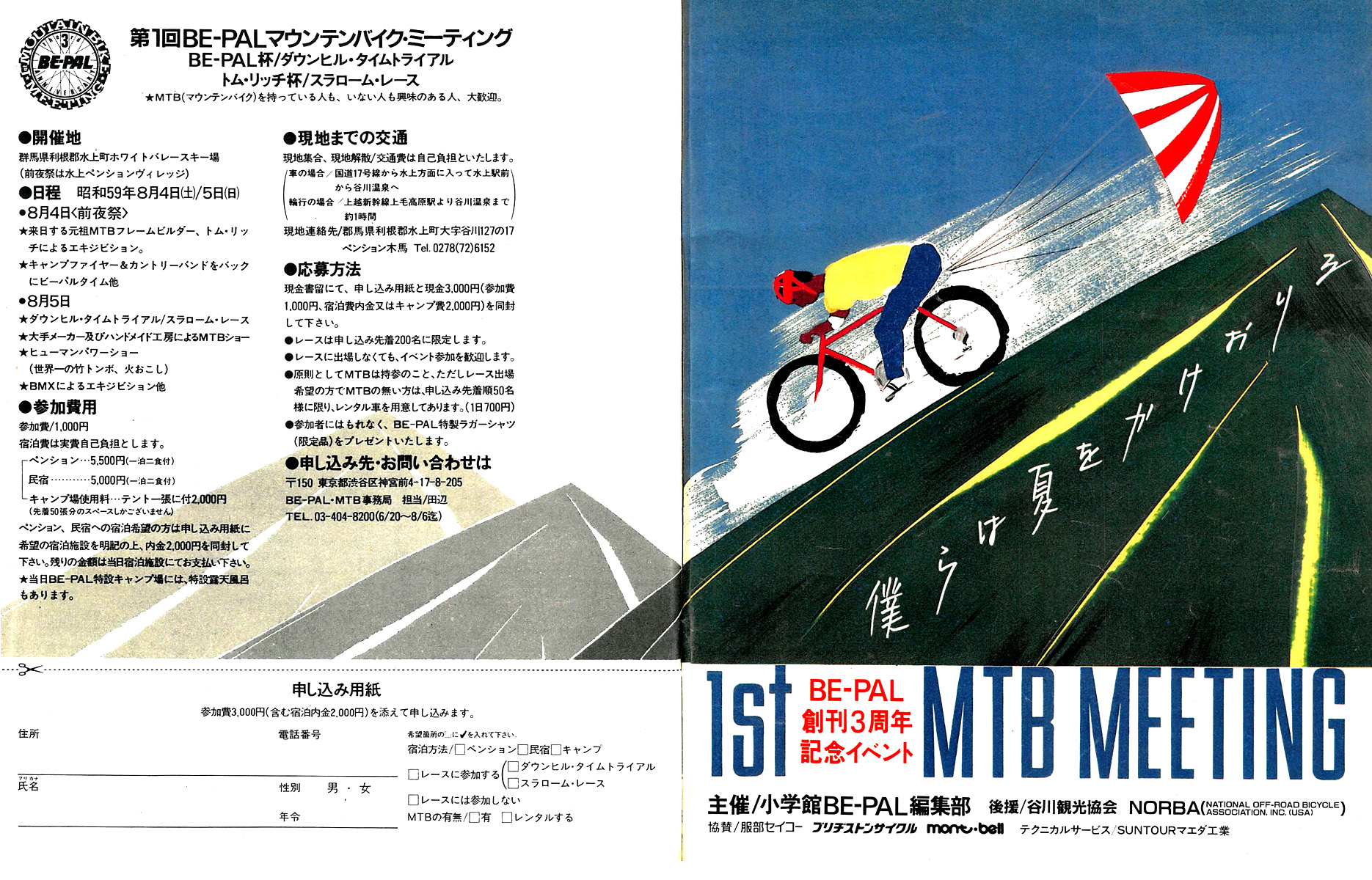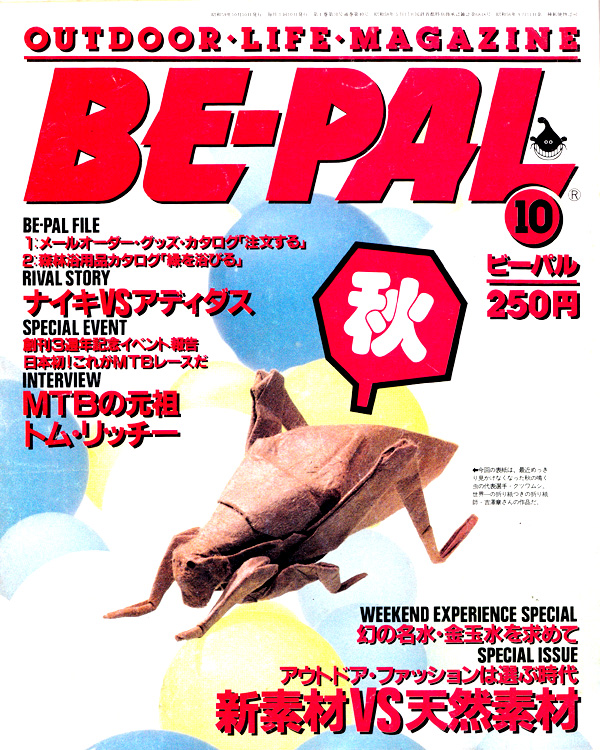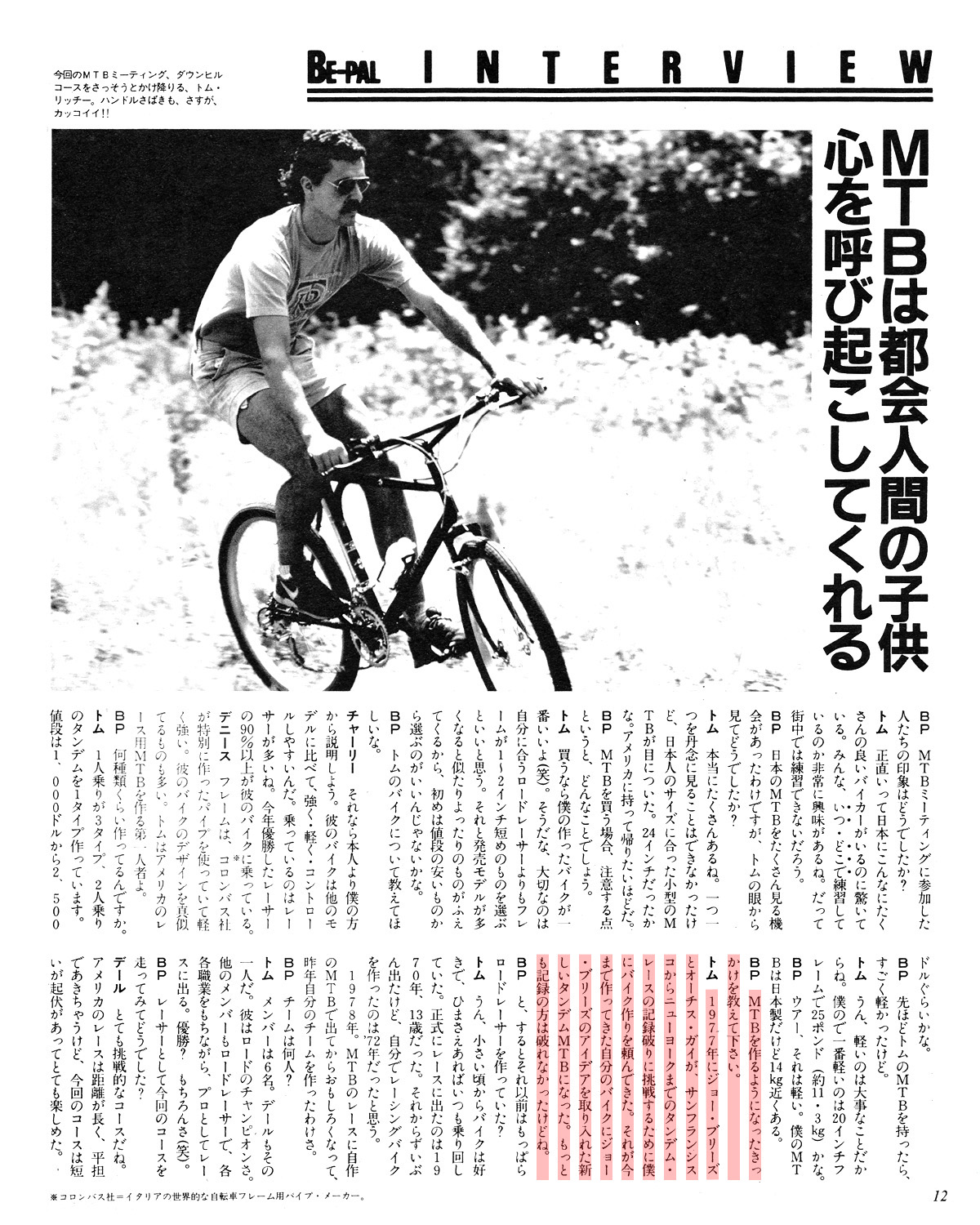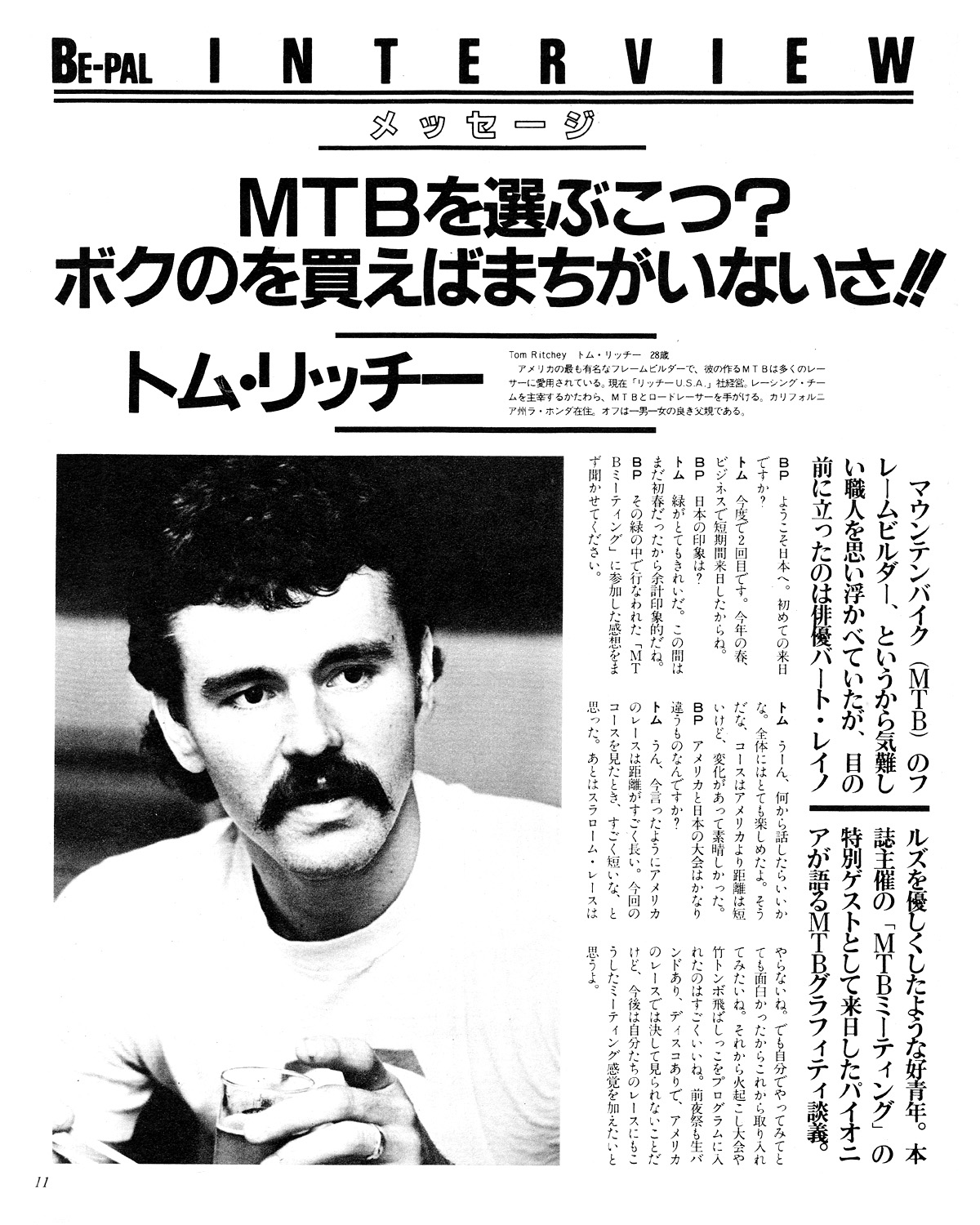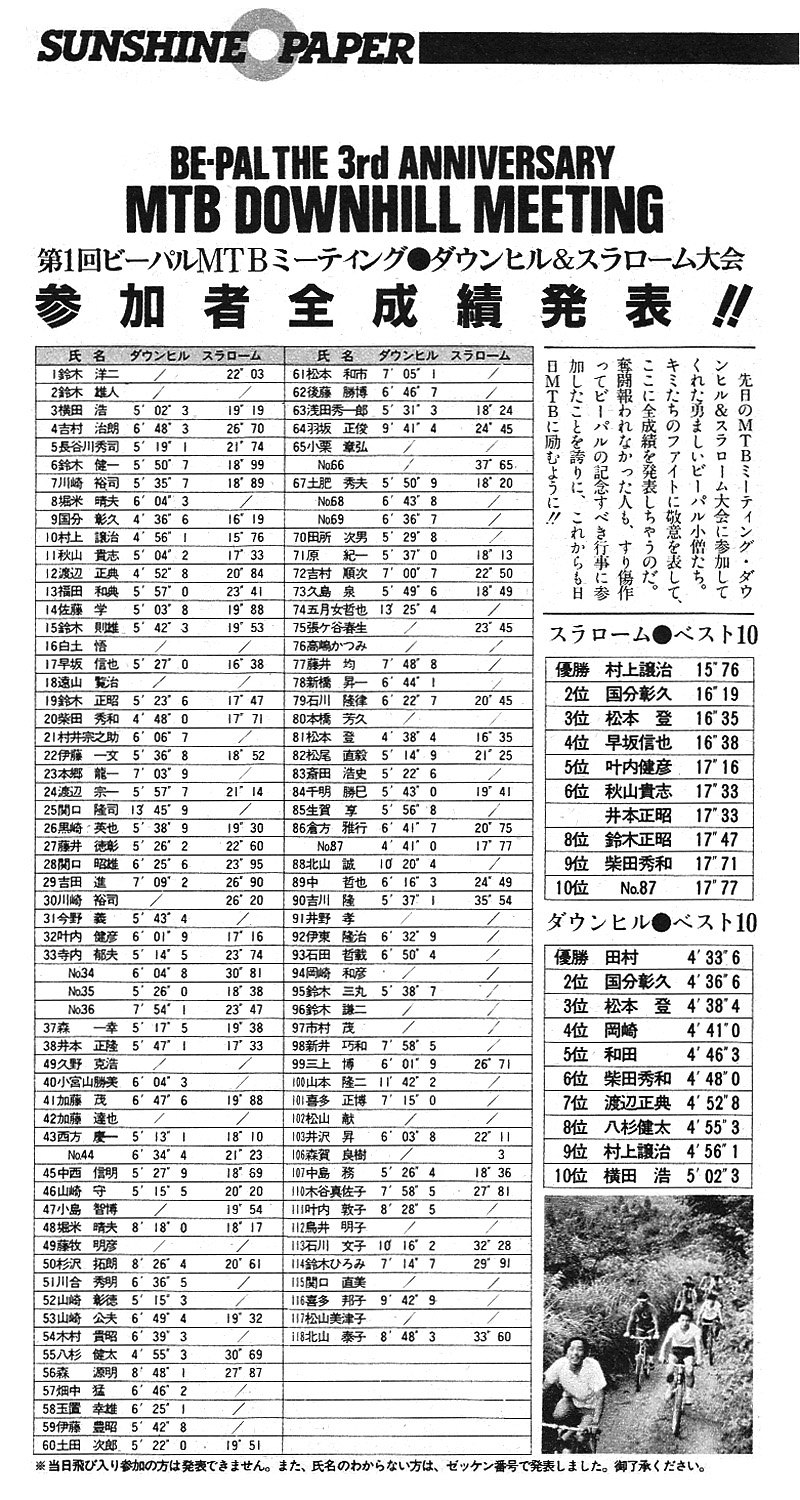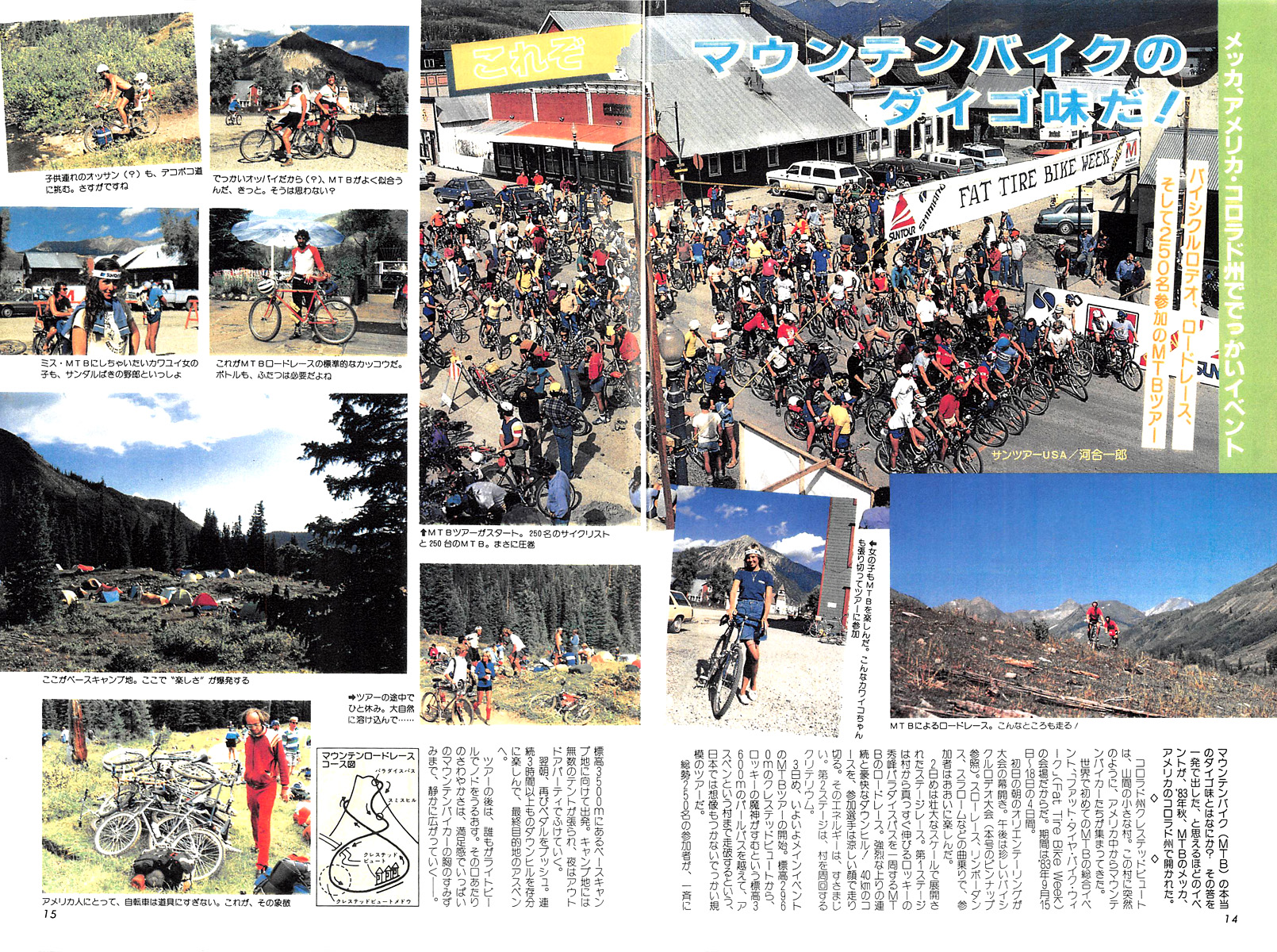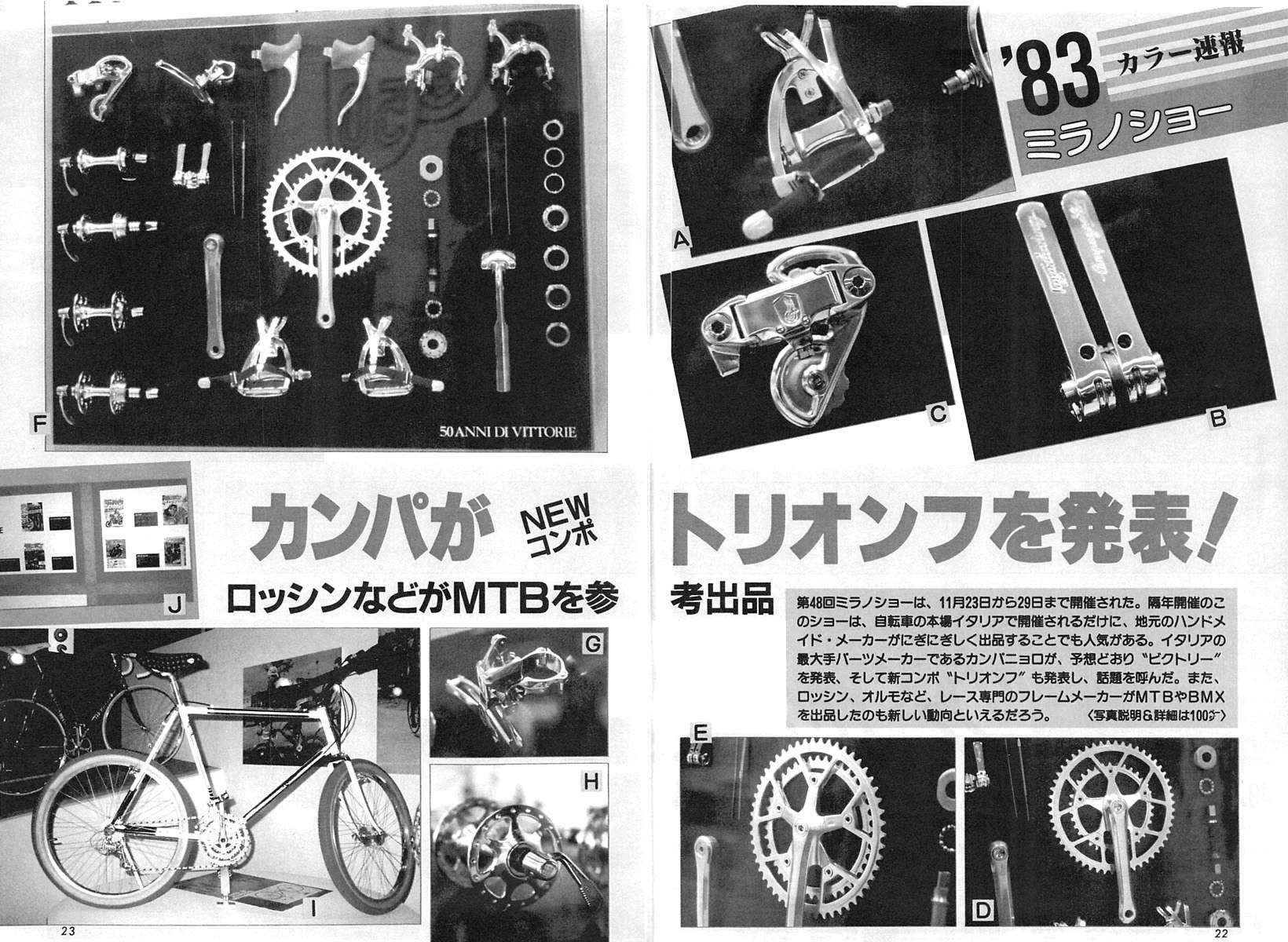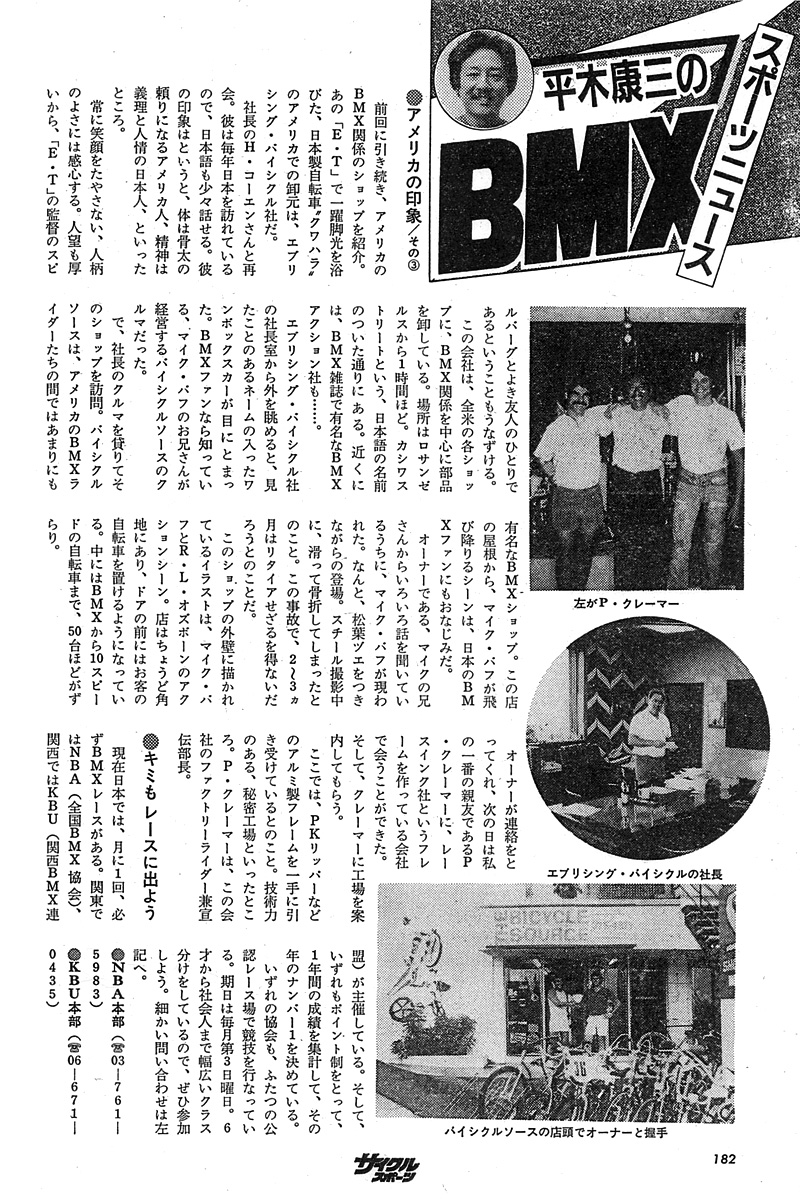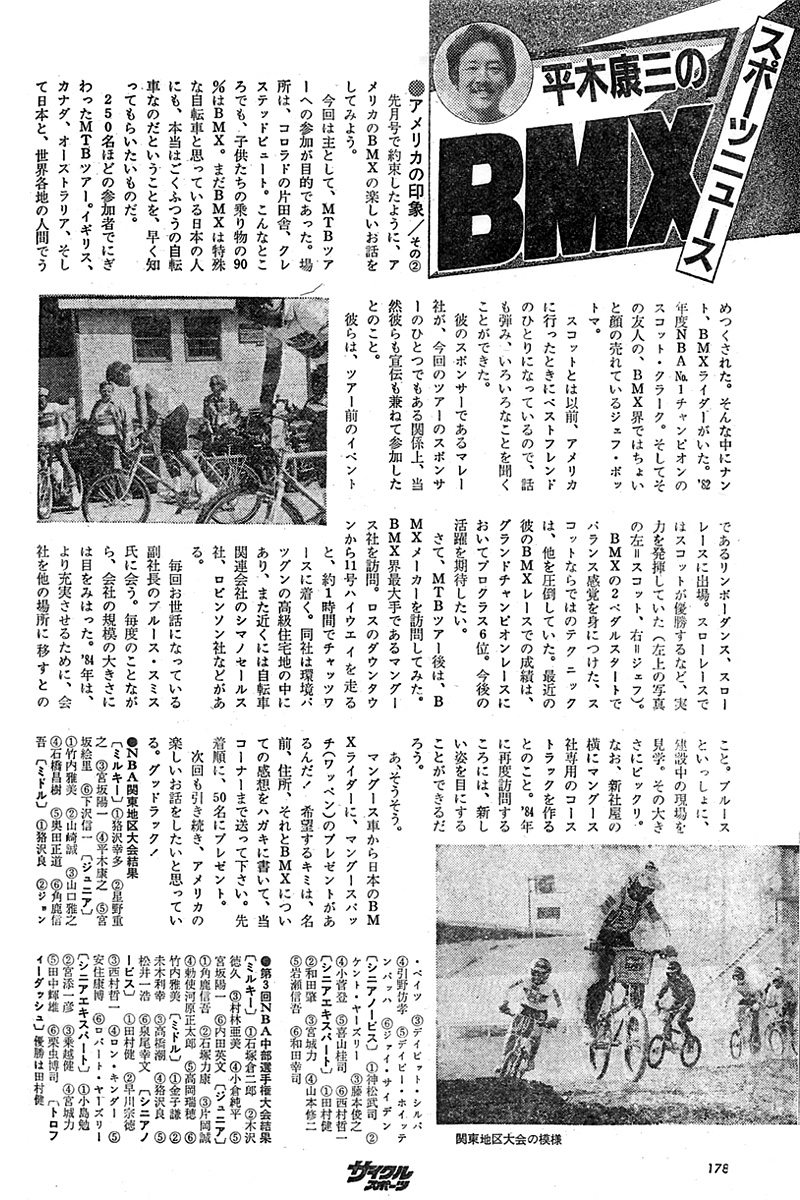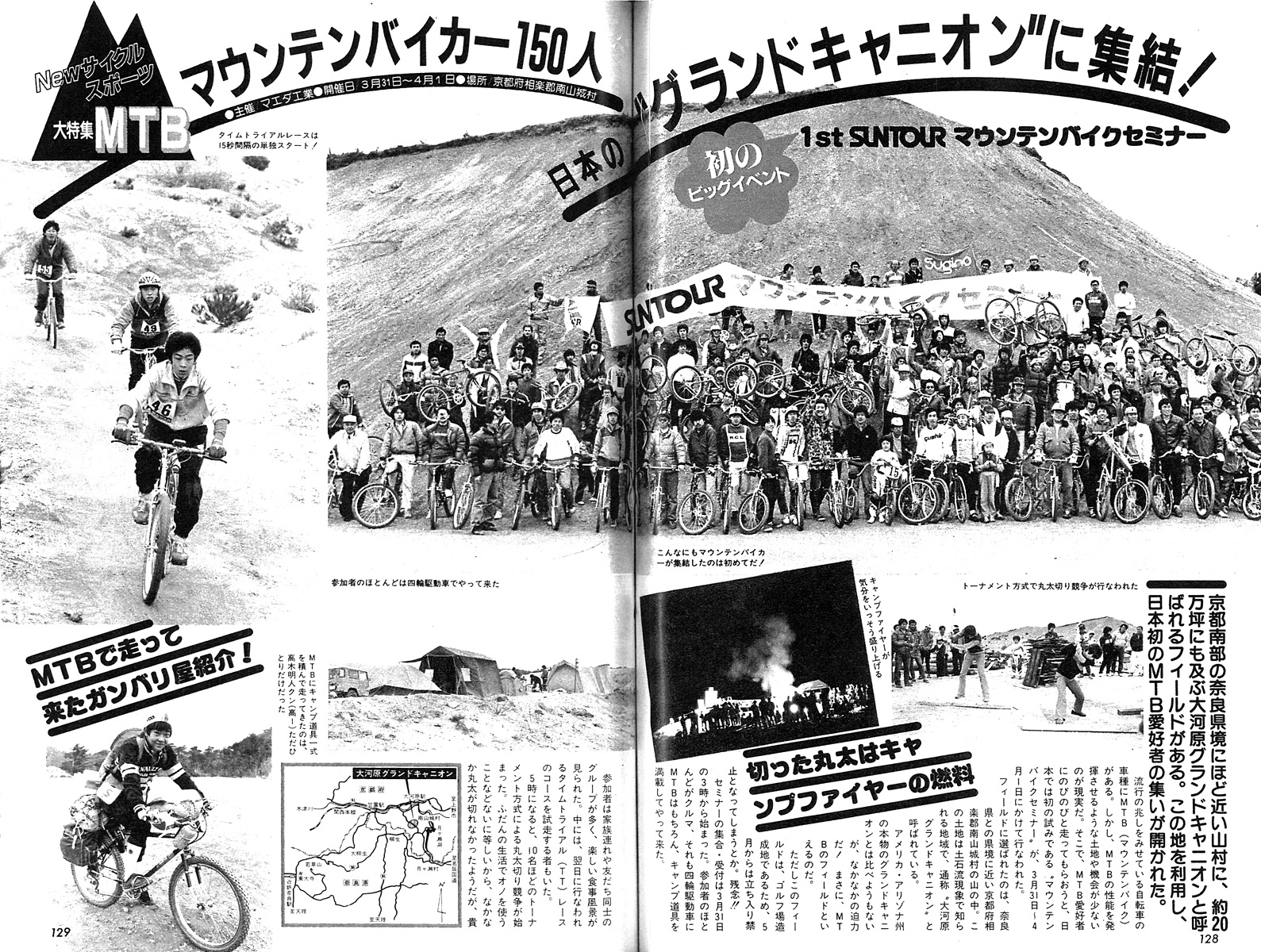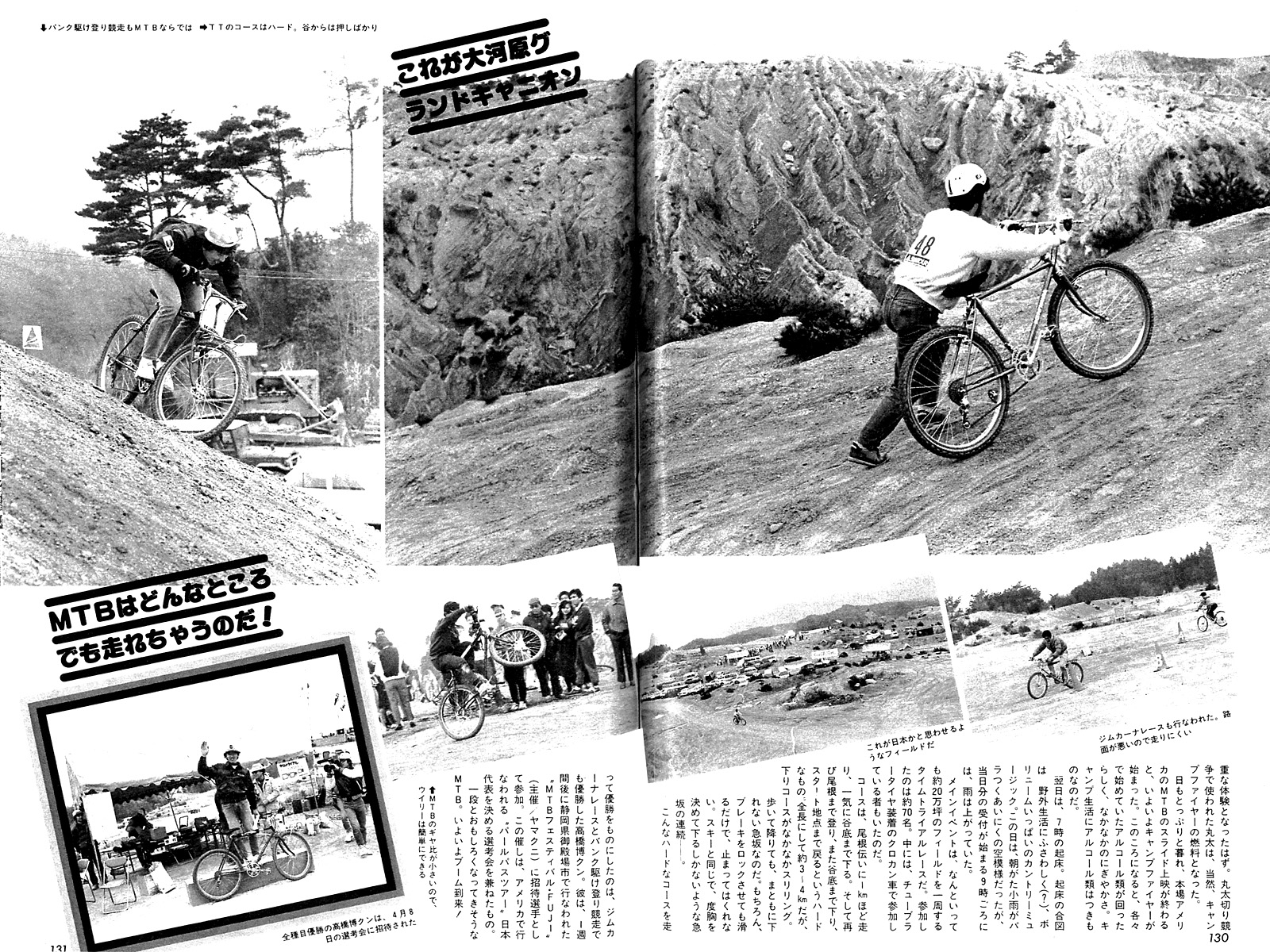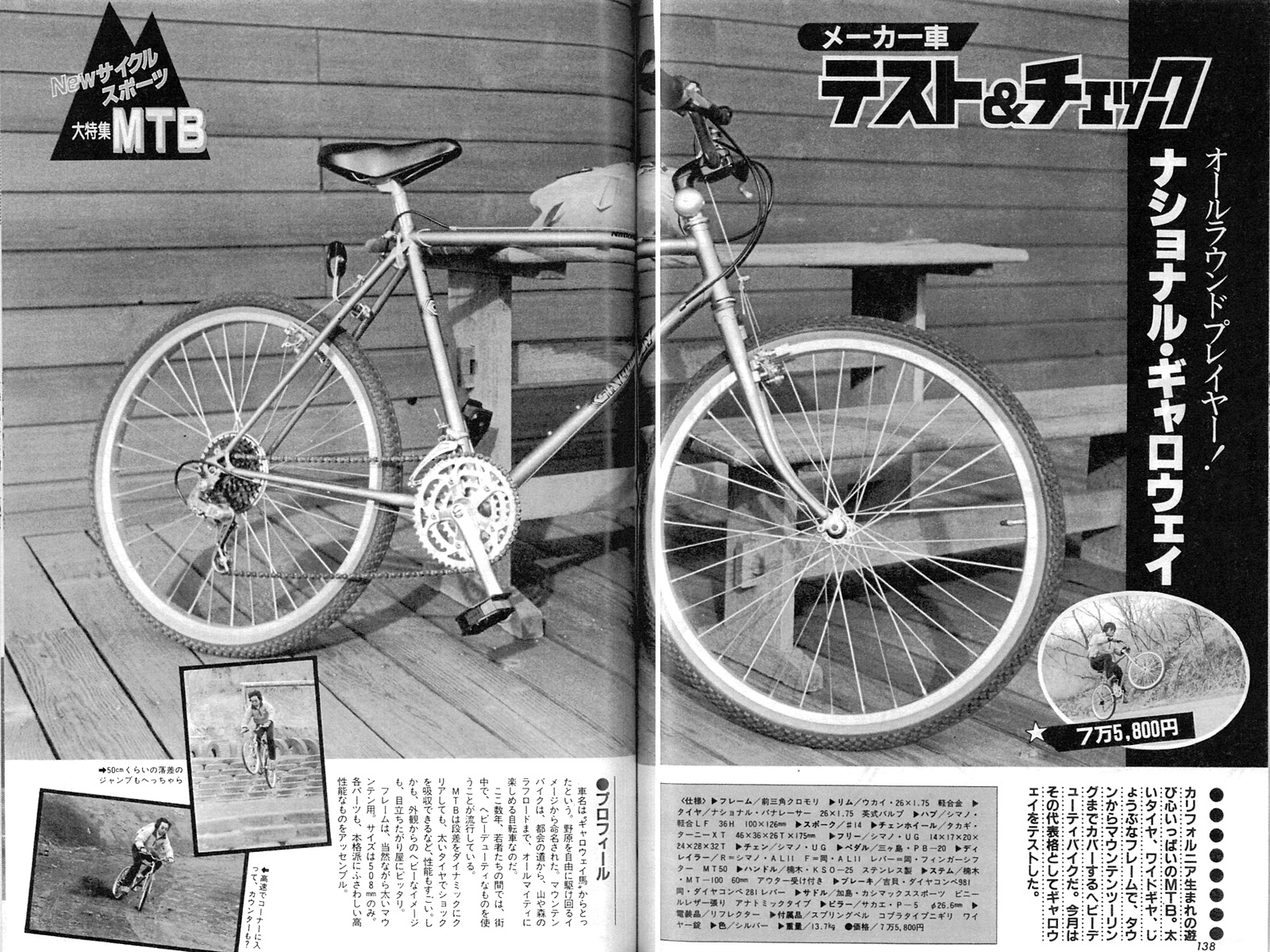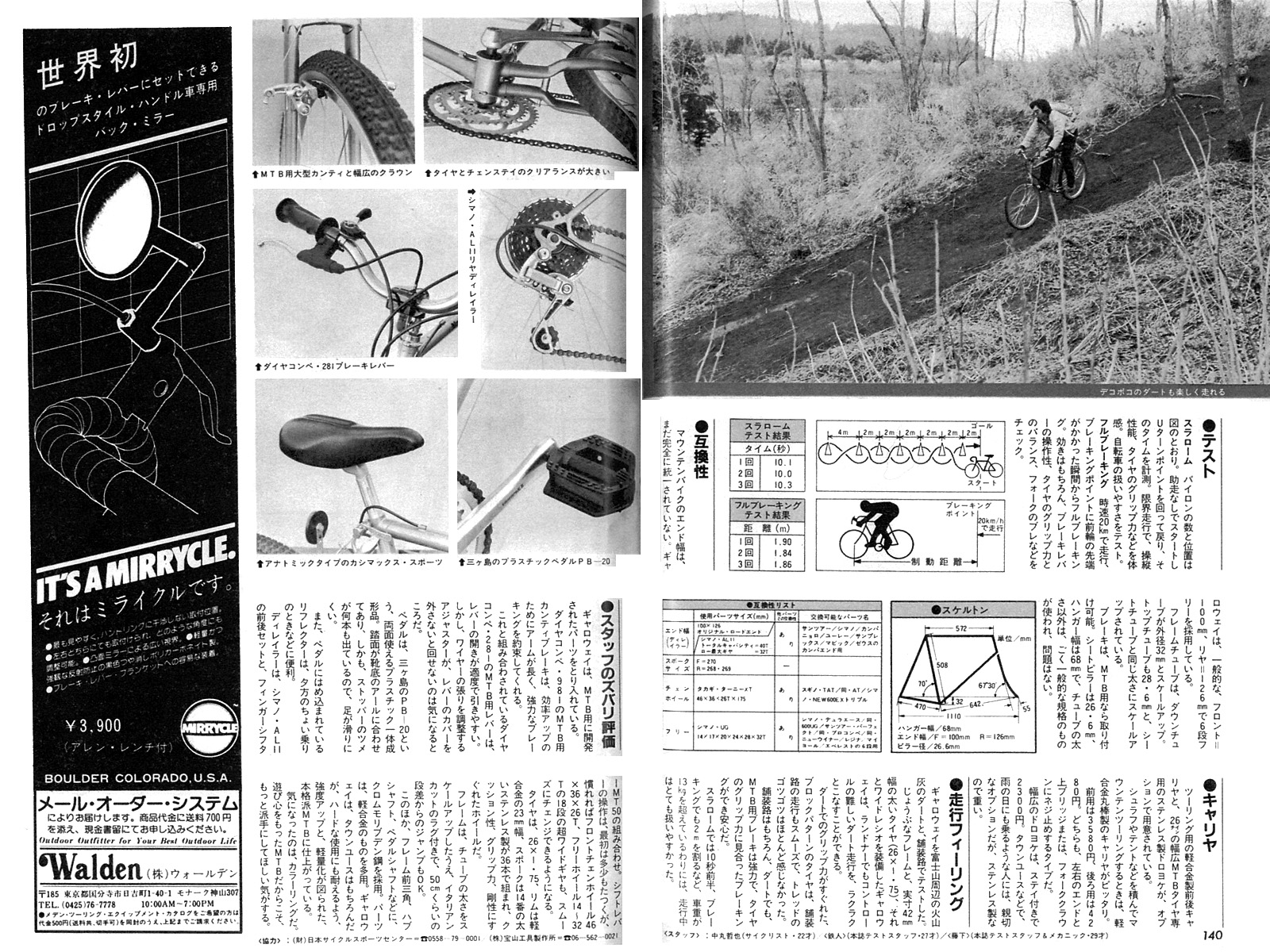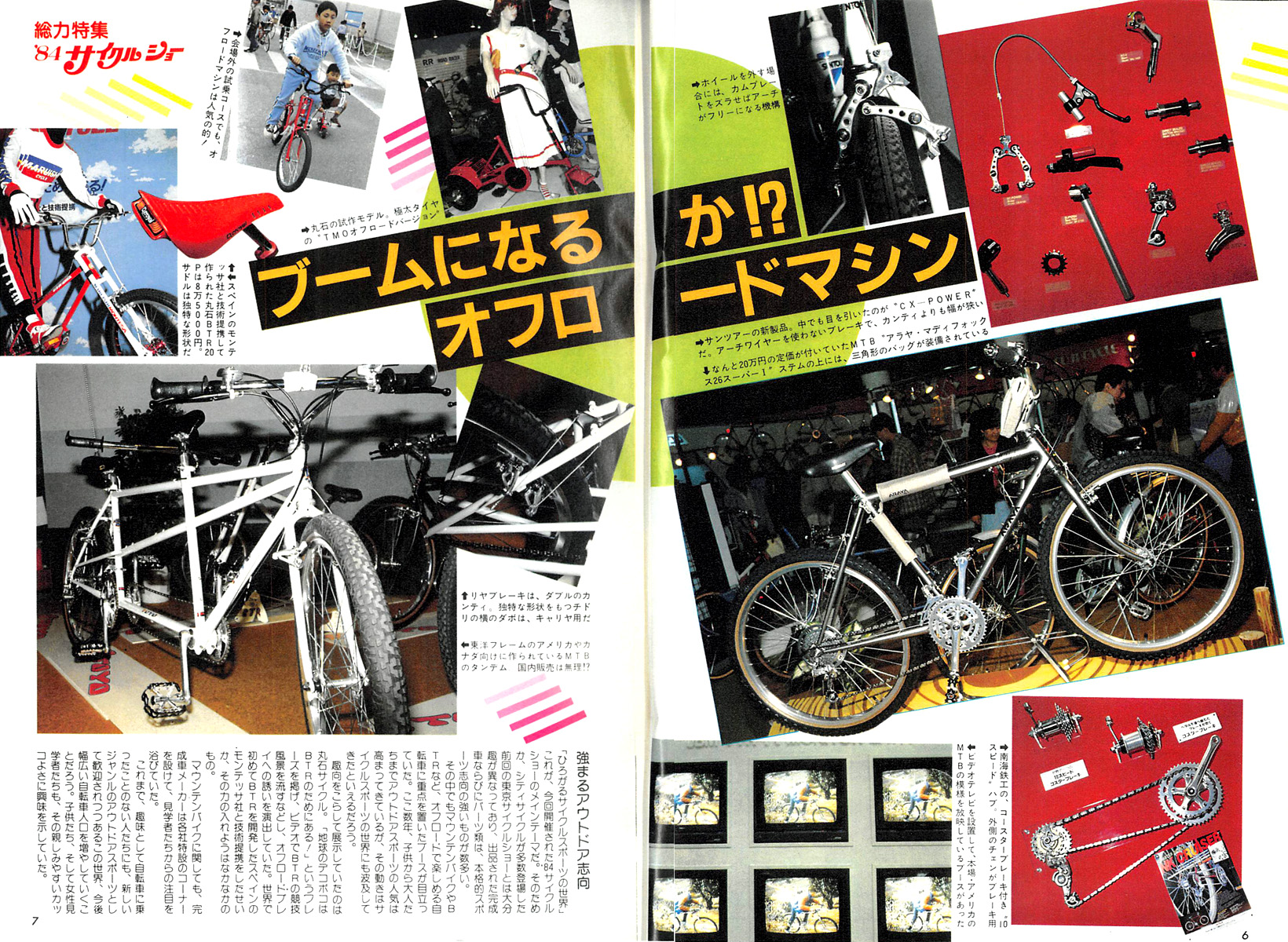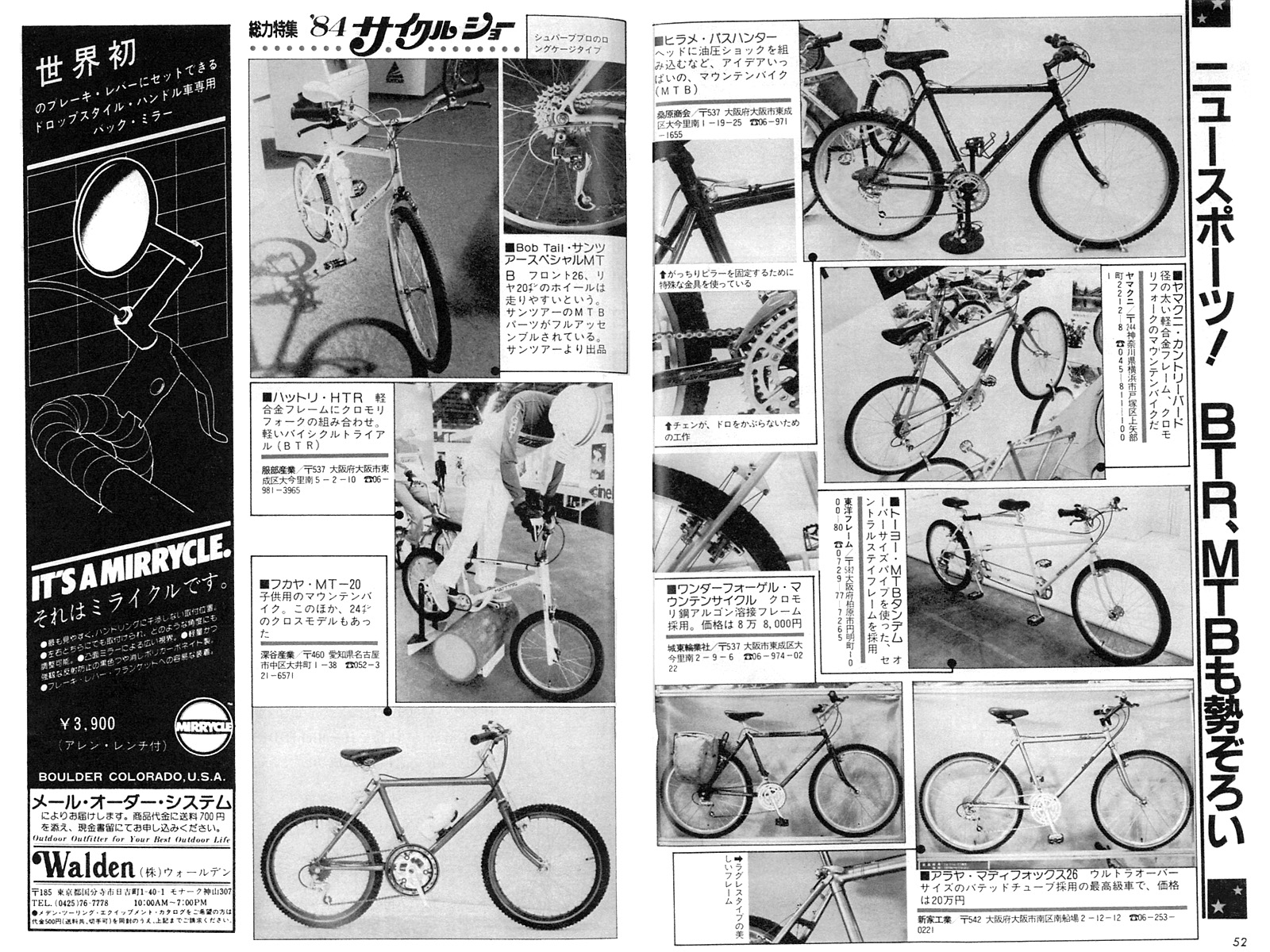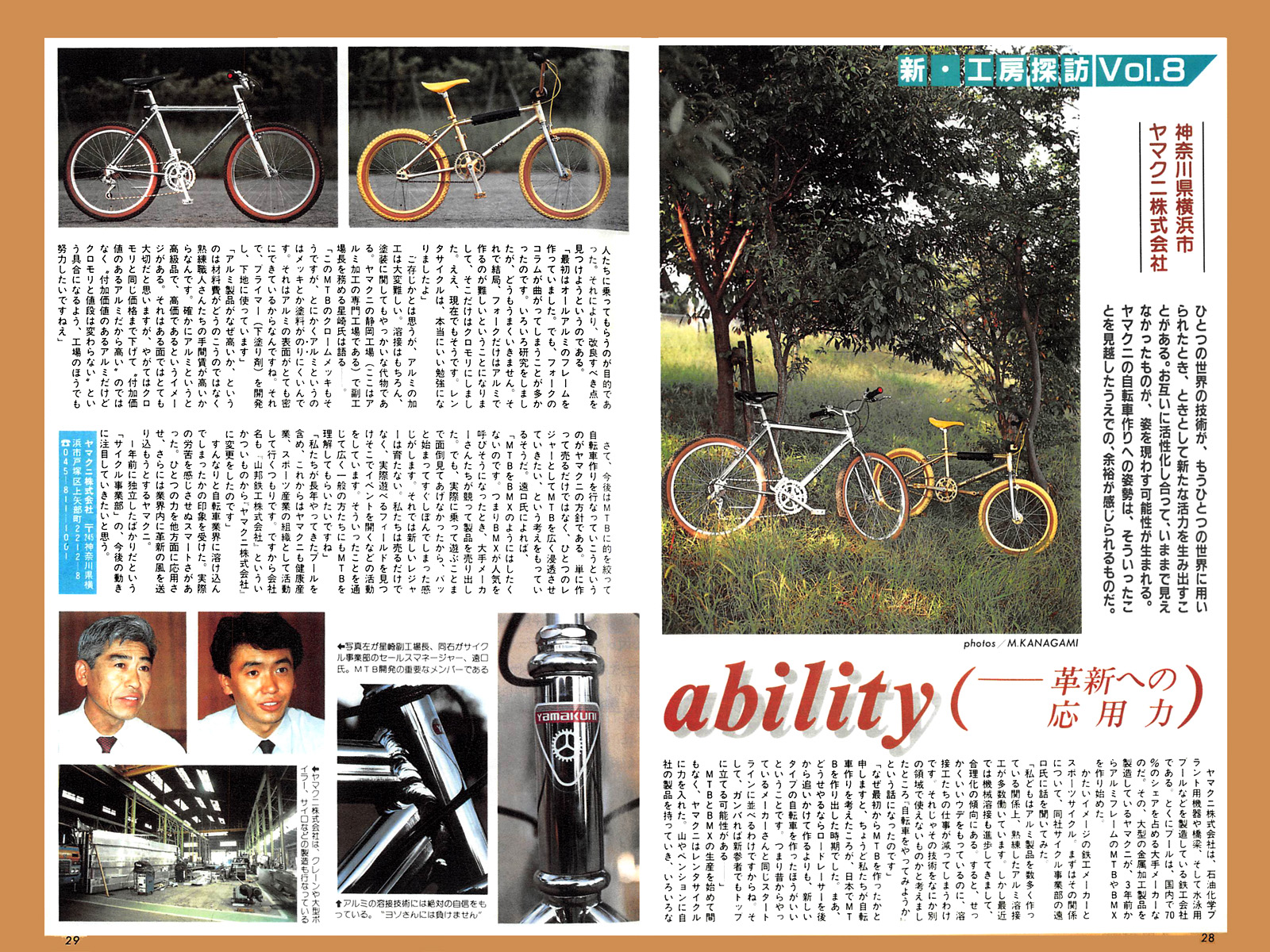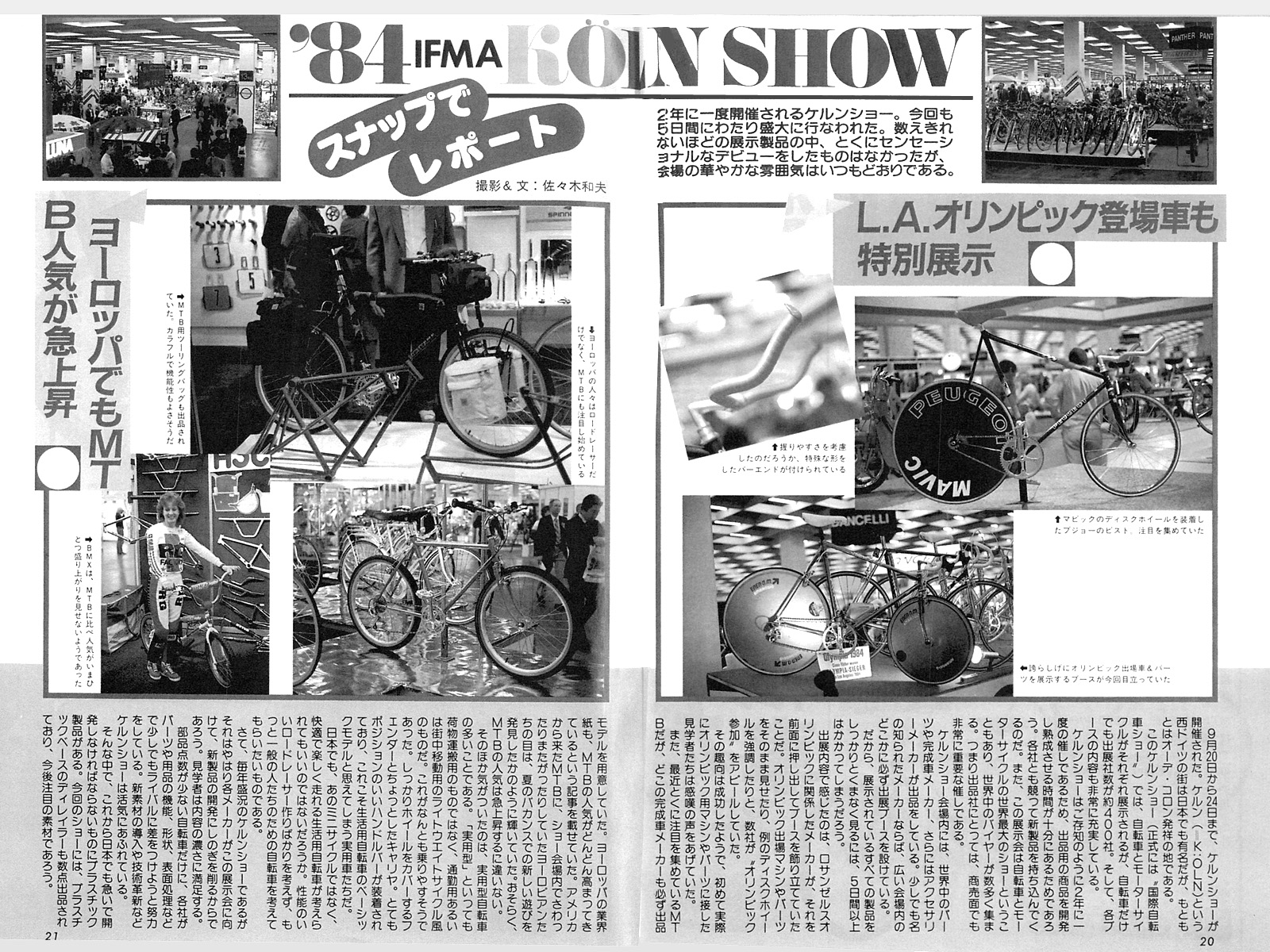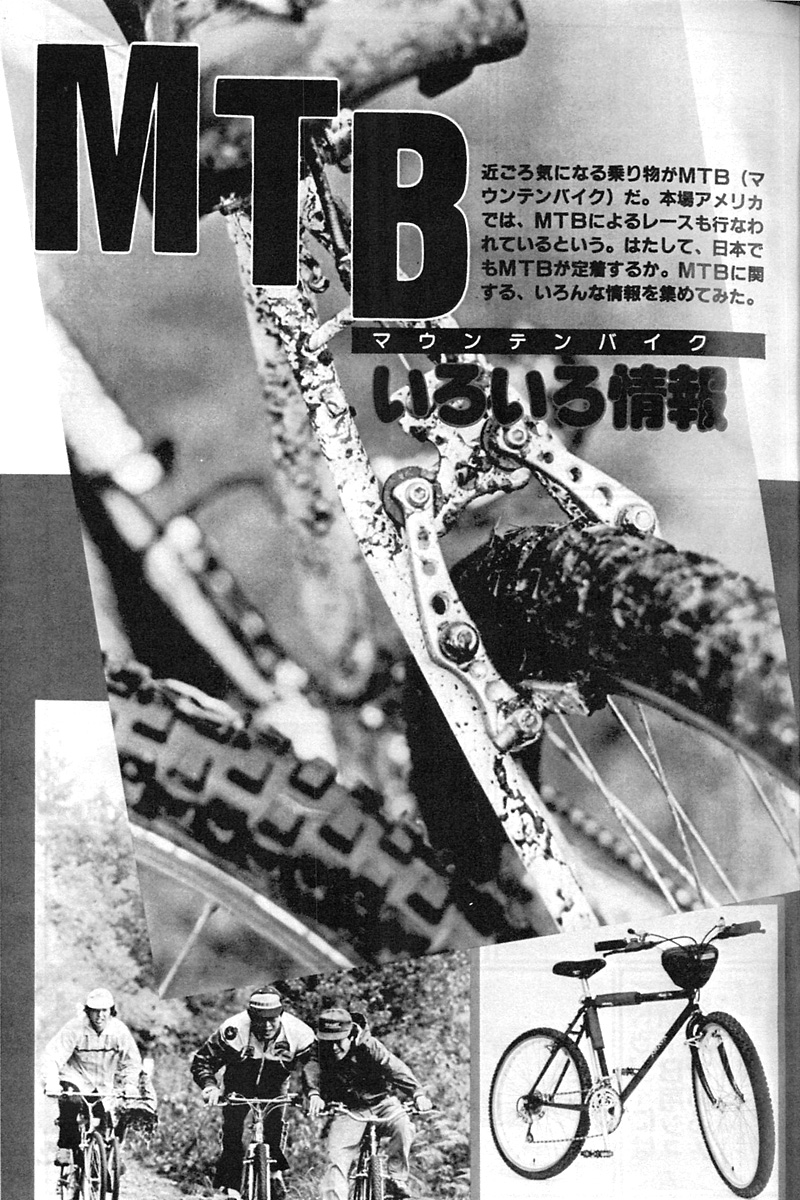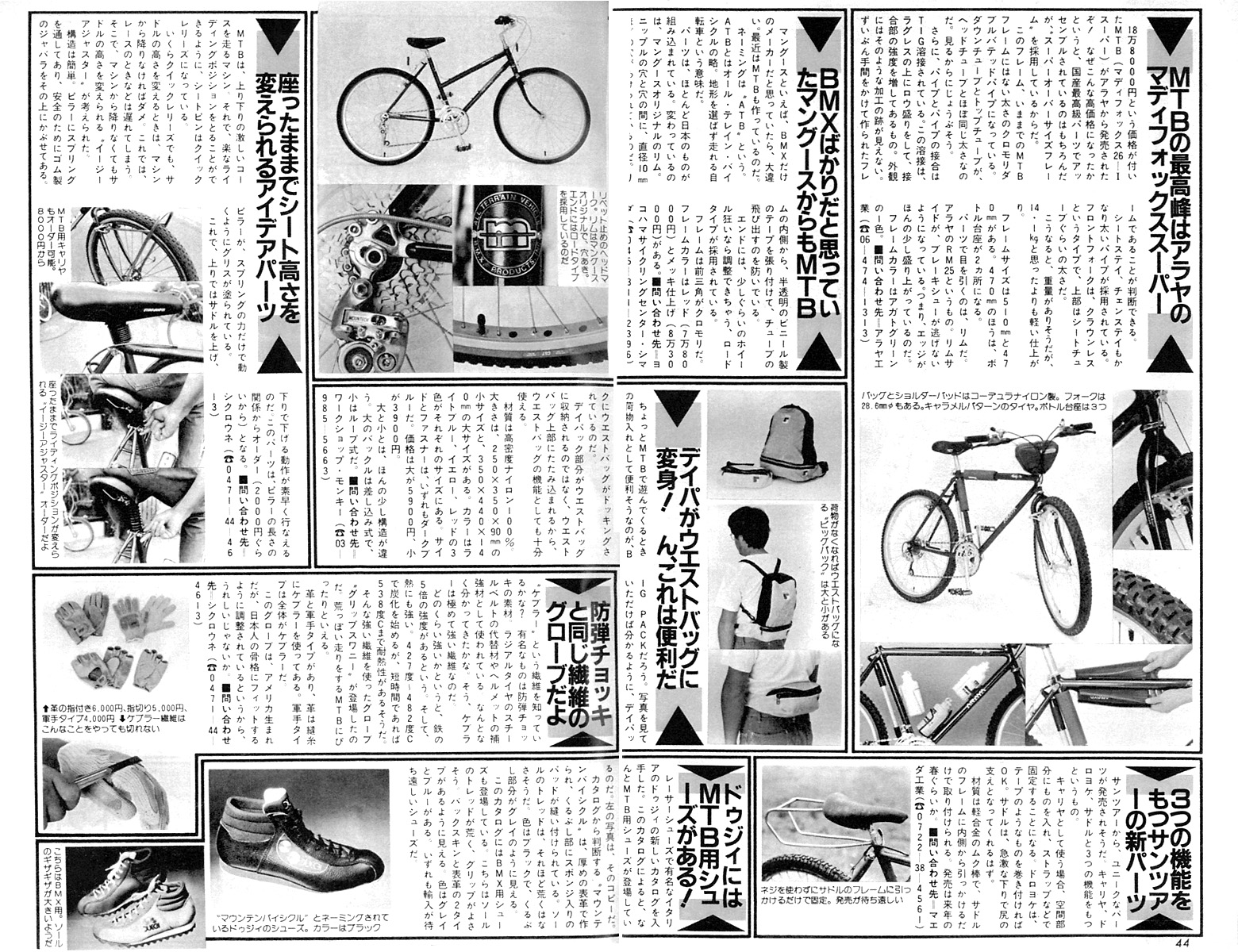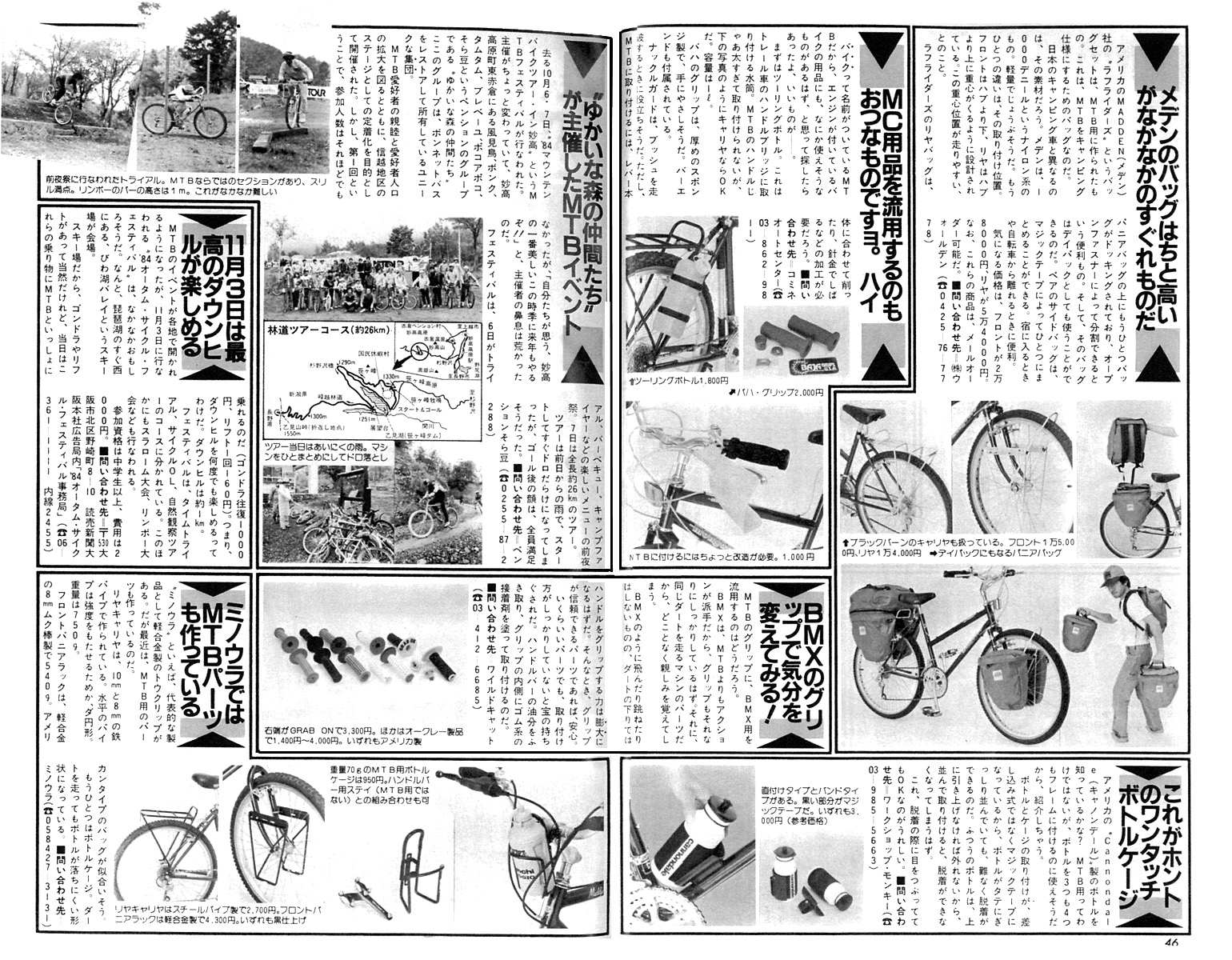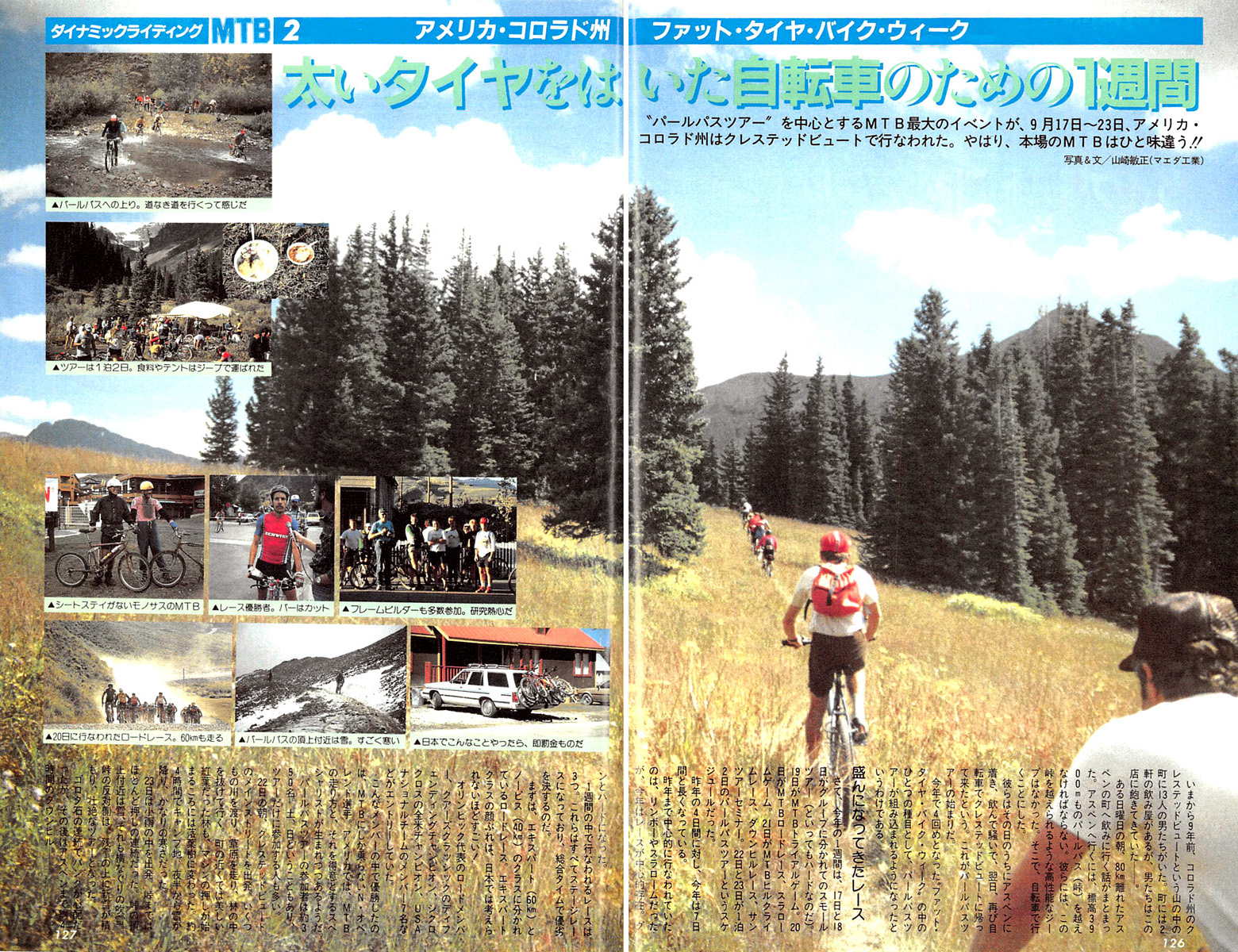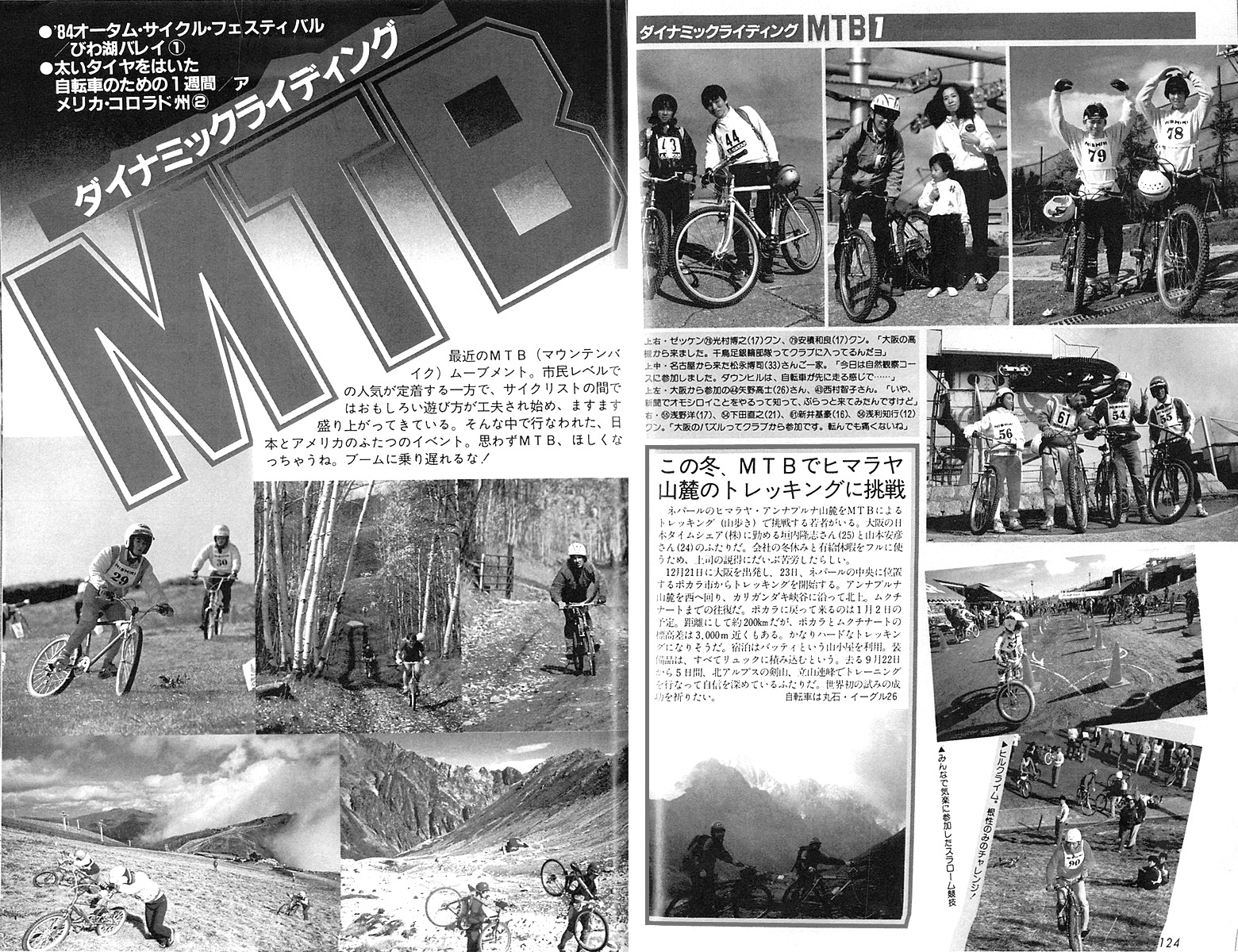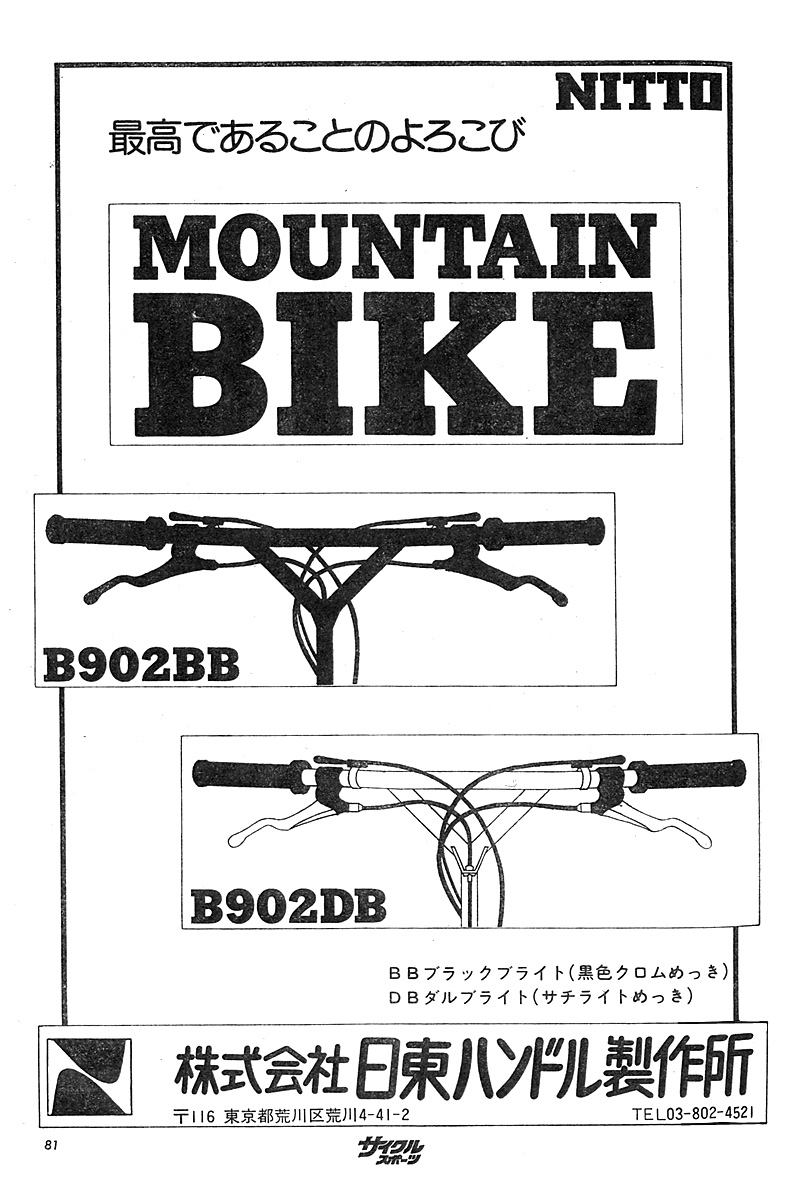
1984年8月 第1回BE-PALマウンテンバイクミーティング
1984年8月5日、ビーパル誌創刊3周年記念イベントとして第1回「BE-PALマウンテンバイクミーティング」が、群馬県みなかみ町のホワイトバレー・スキー場で開催された。このミーティングでダウンヒルとスラロームのレースが行われ、これが日本最初のMTB競技会とされている。

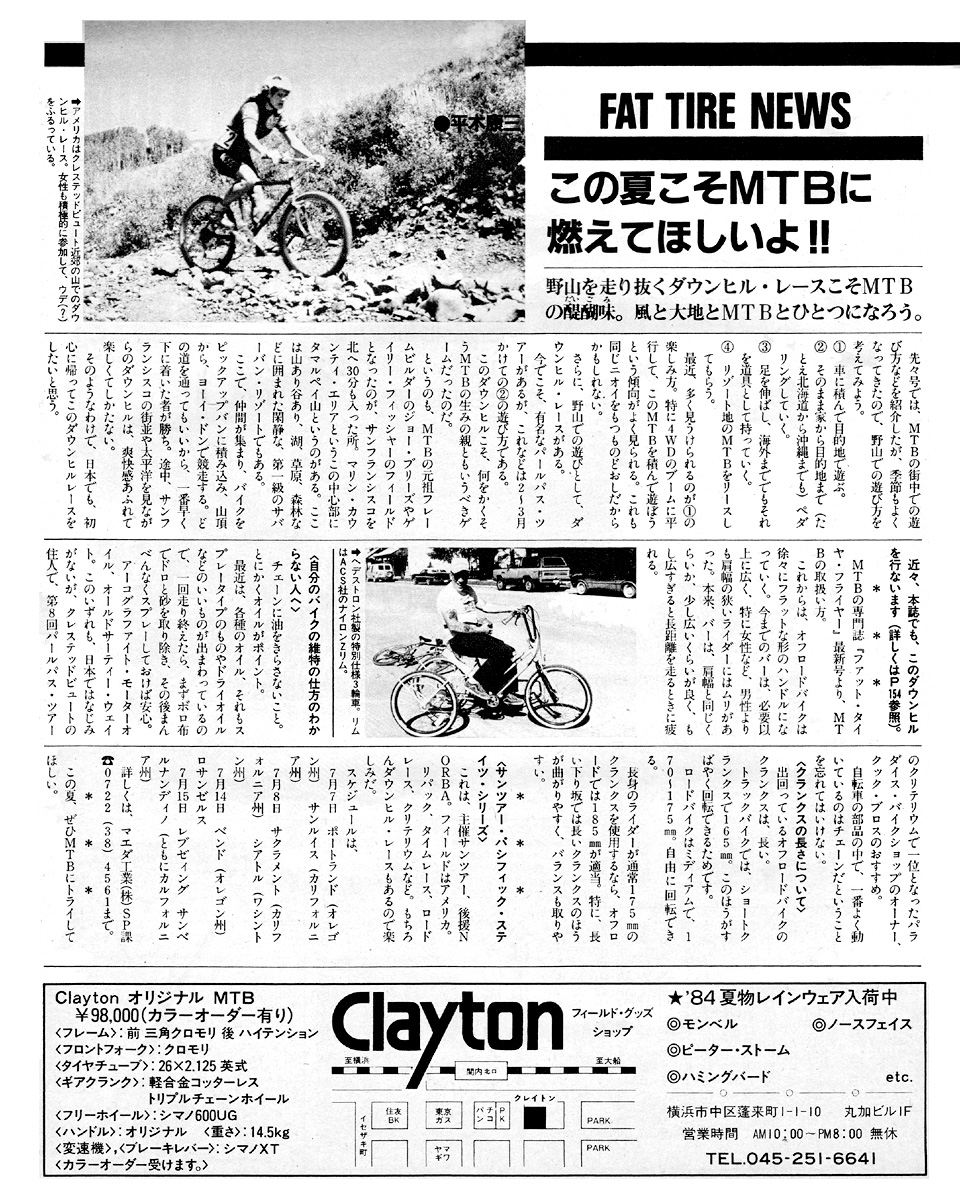
このイベントには、誌面を見て参加したビーパル愛読者の他、BMX選手や地元のスキーヤーらが動員された。他、メーカーやショップのワークスチームの参加もあった。(サンツアー、シマノ、アラヤ、クワハラ、モトクロスインターナショナル、三連勝、ワイルドキャット)さらに、サンツアーUSAの社長(当時)、河合一郎氏の尽力で、US本国から、トム・リッチー、チャールズ・ケリー、デニス・カラマーニョ、デイル・ステティーナ(Dale Stetina:1976年モントリオールオリンピック自転車競技US代表)の4名が招待されている。
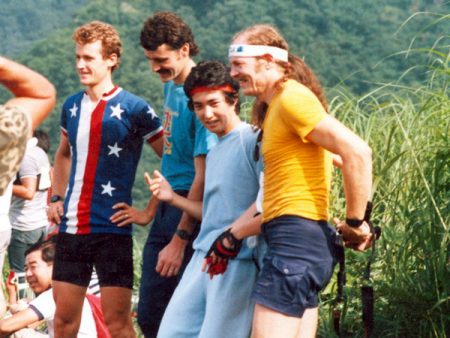
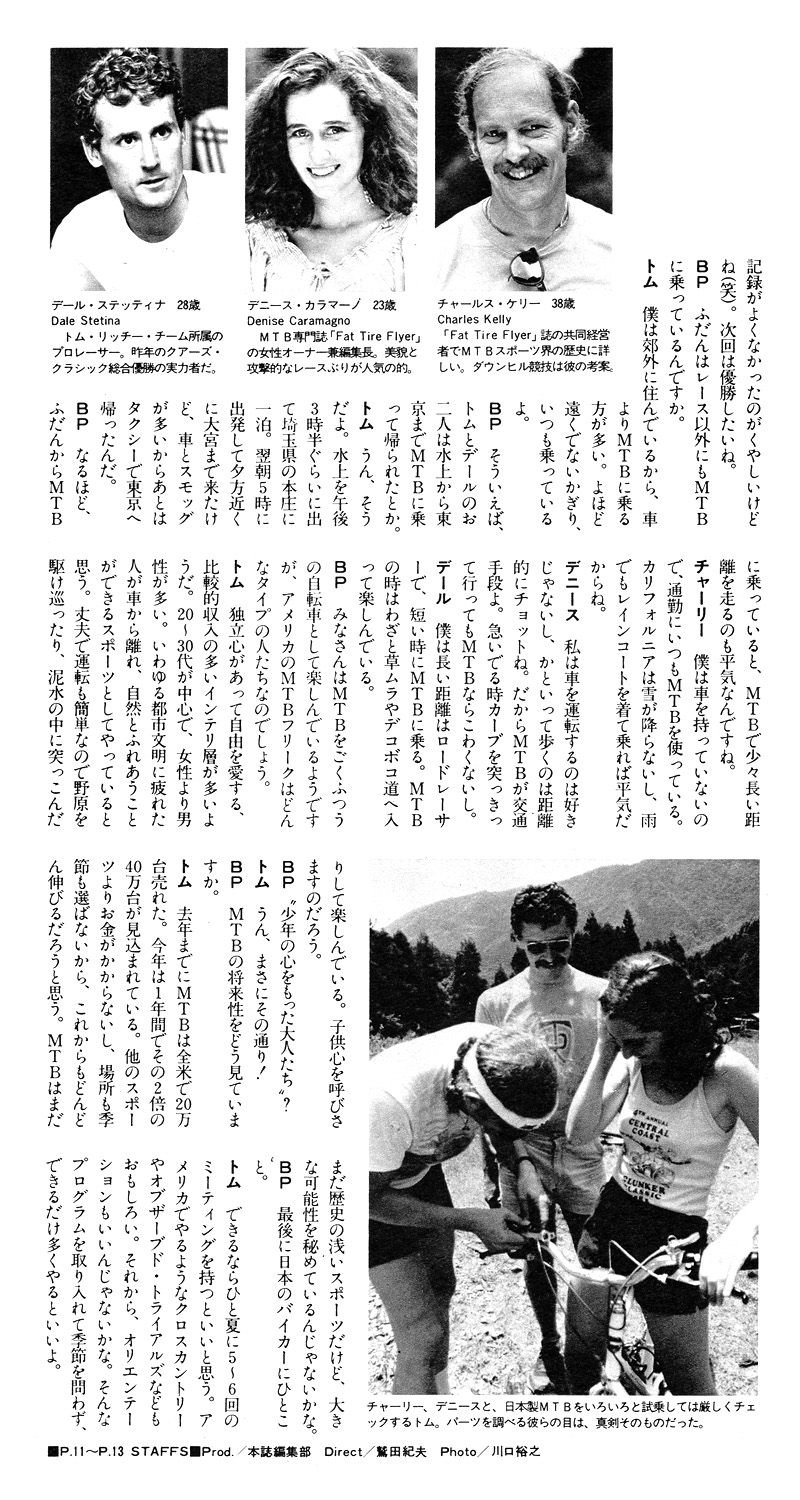
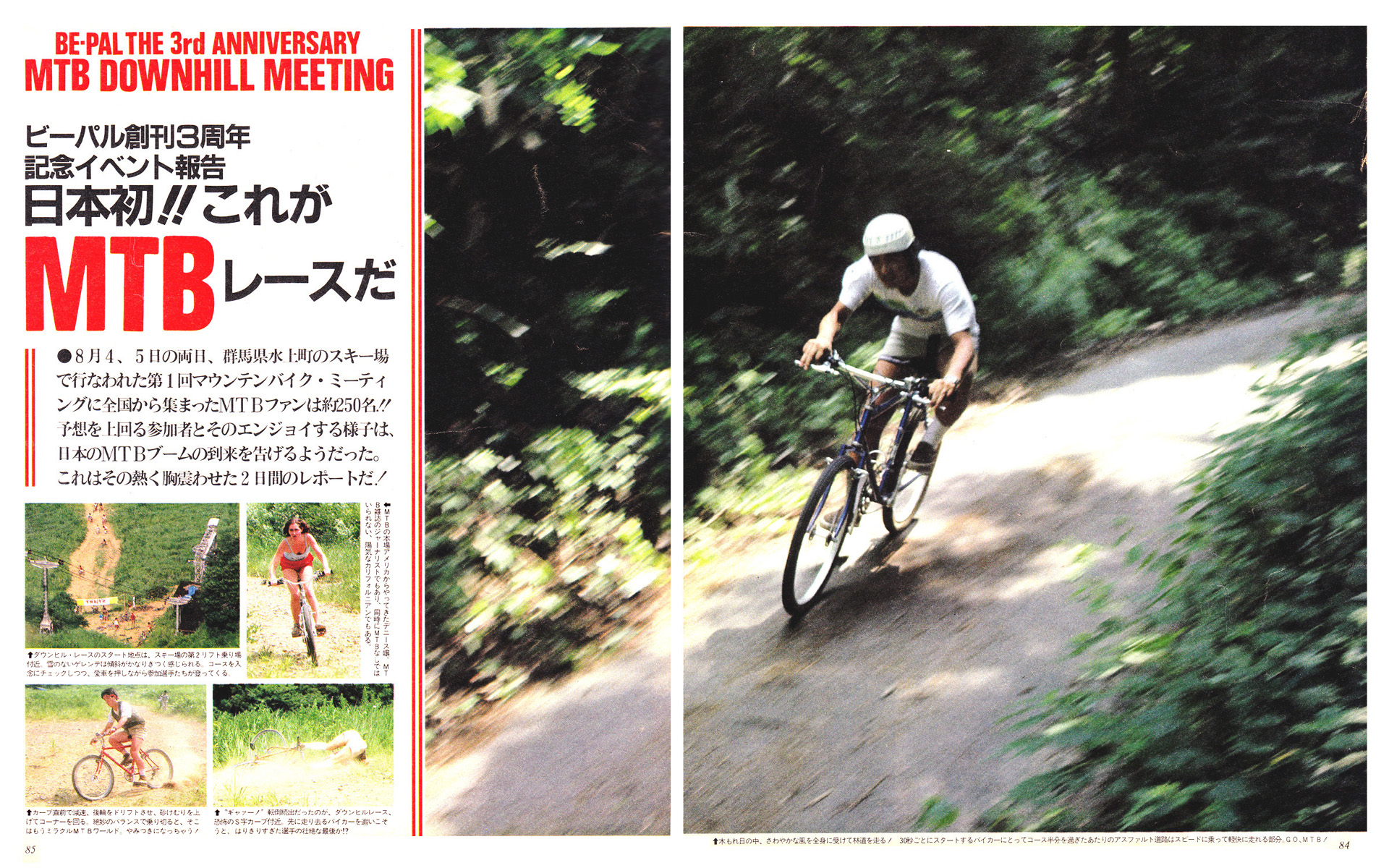
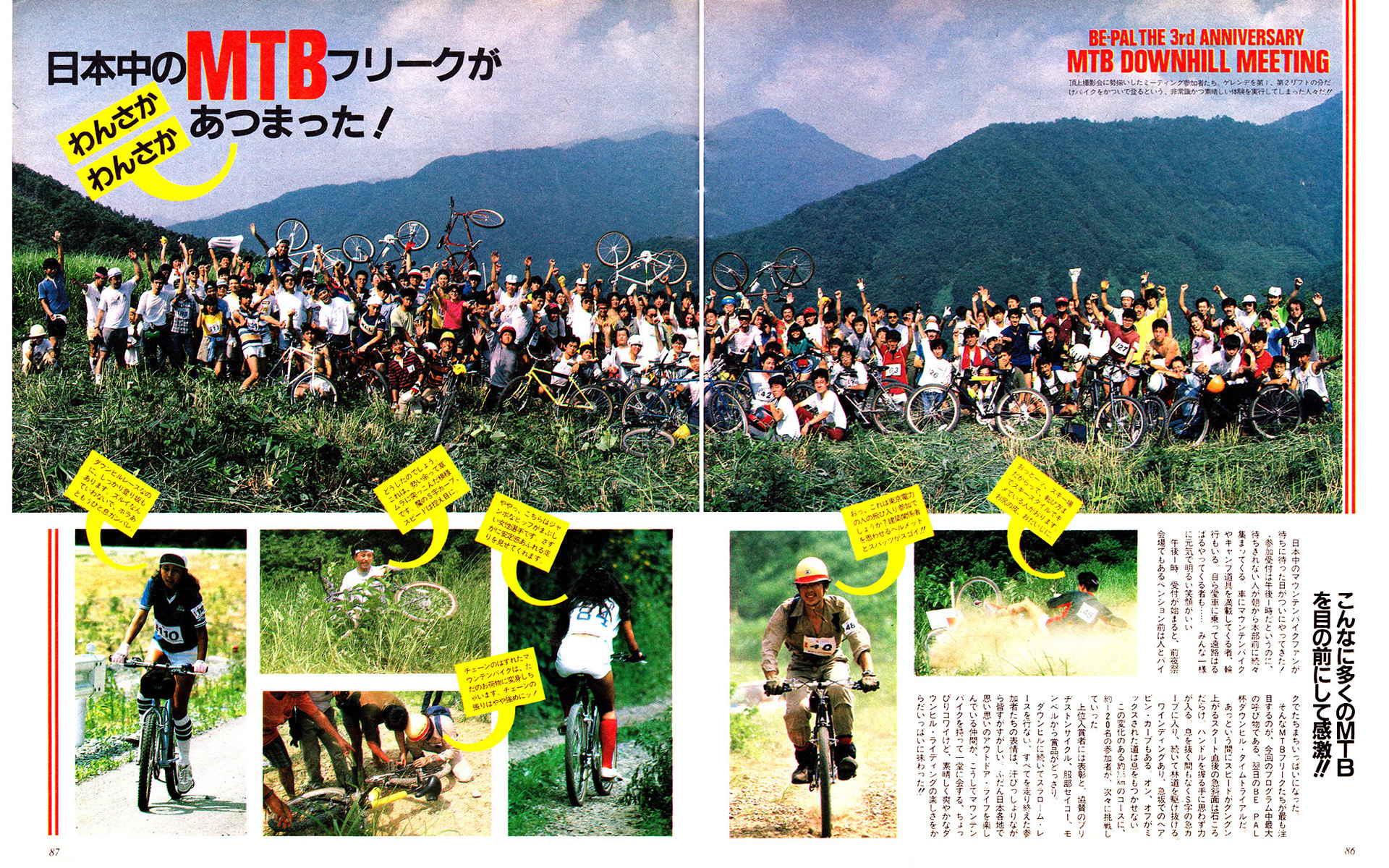
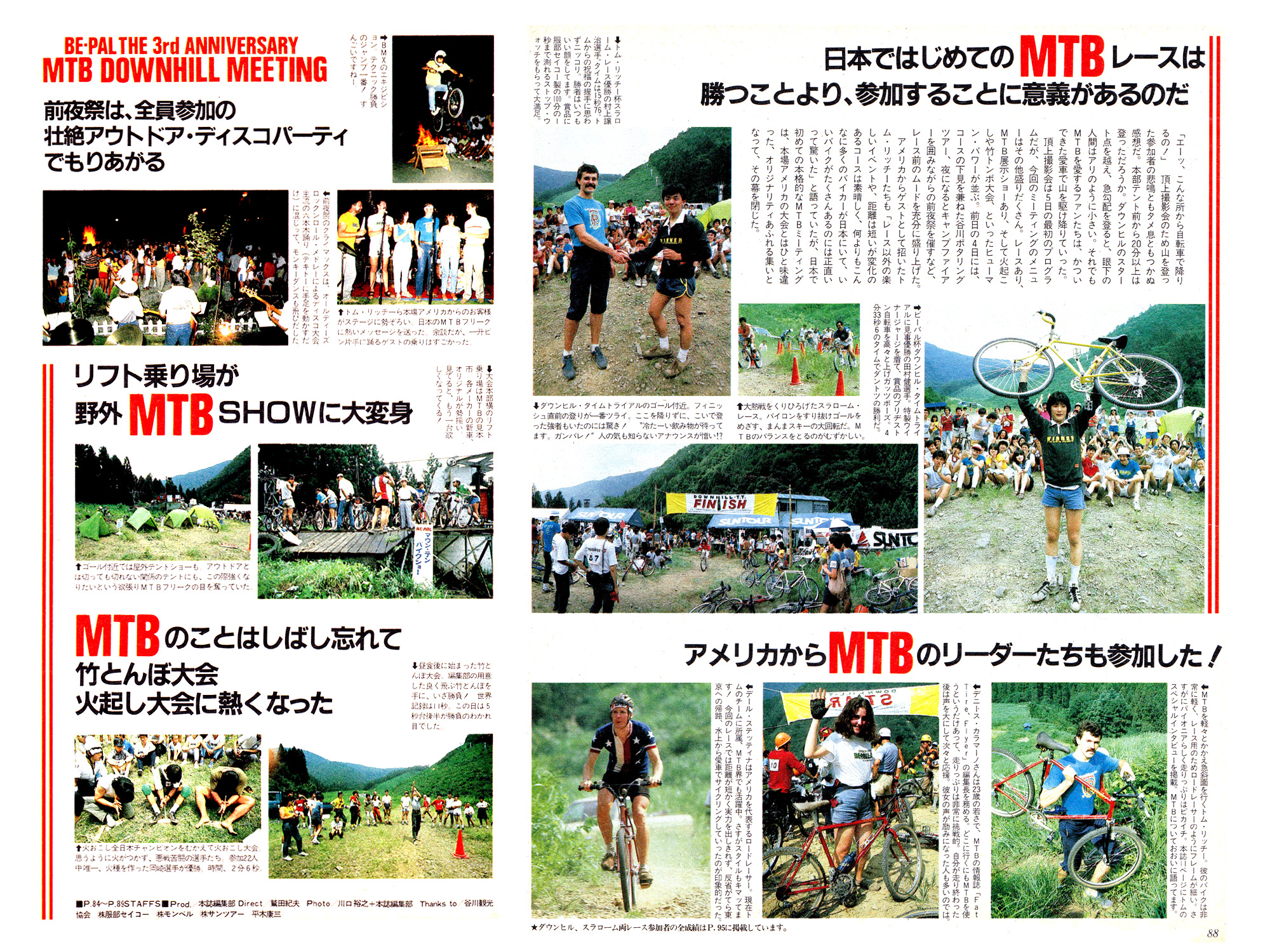
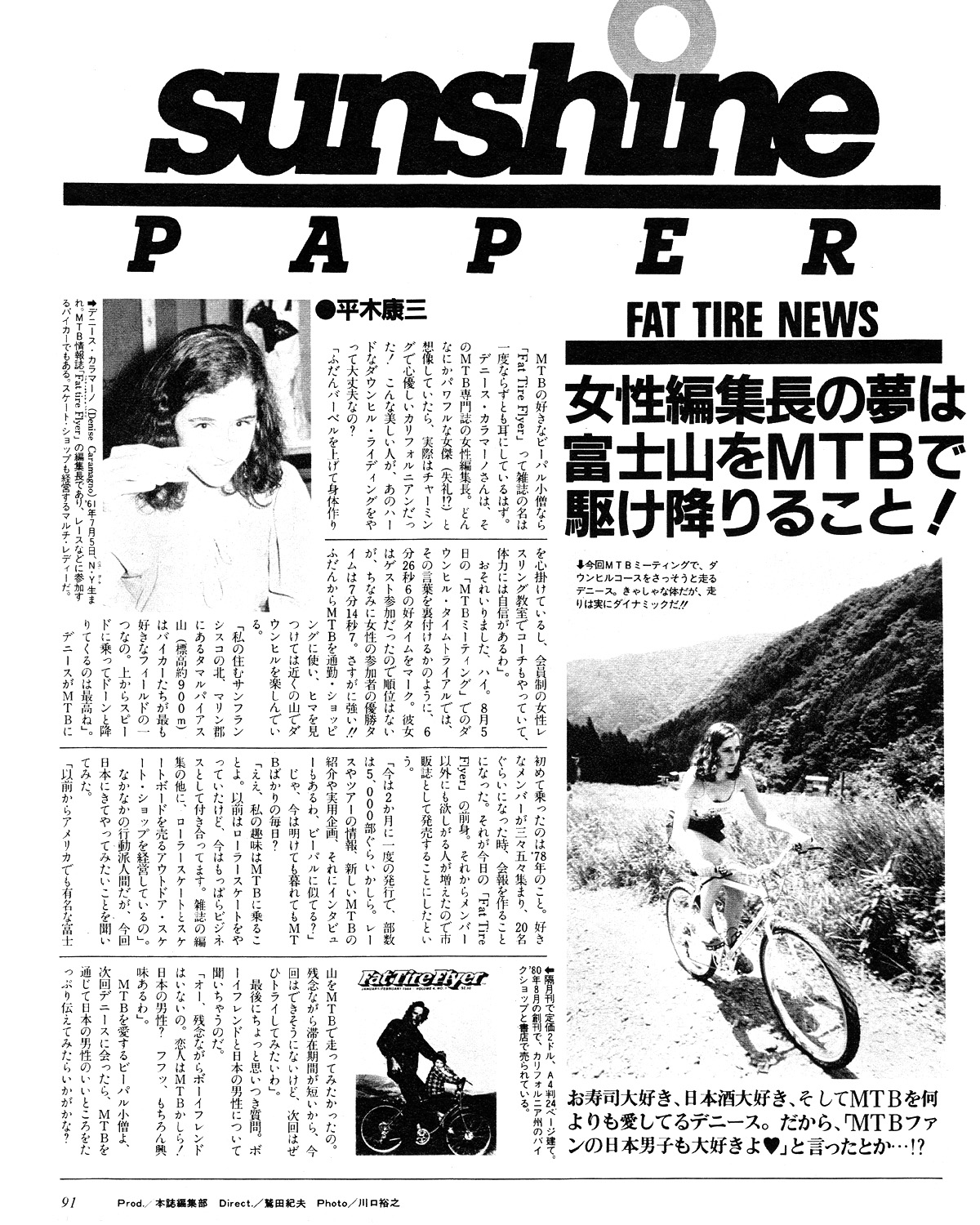
ダウンヒルの上位3名は、1位トム・リッチー(4分4秒)2位デイル・ステティーナ(4分21秒)3位日本人最高位・田村健氏(4分33秒)とのこと。(実際には招待選手は章典外)チャールズ・ケリーは6位とのことなので、日本人3位(4分38秒)と4位(4分41秒)の間のタイムだったのであろう。
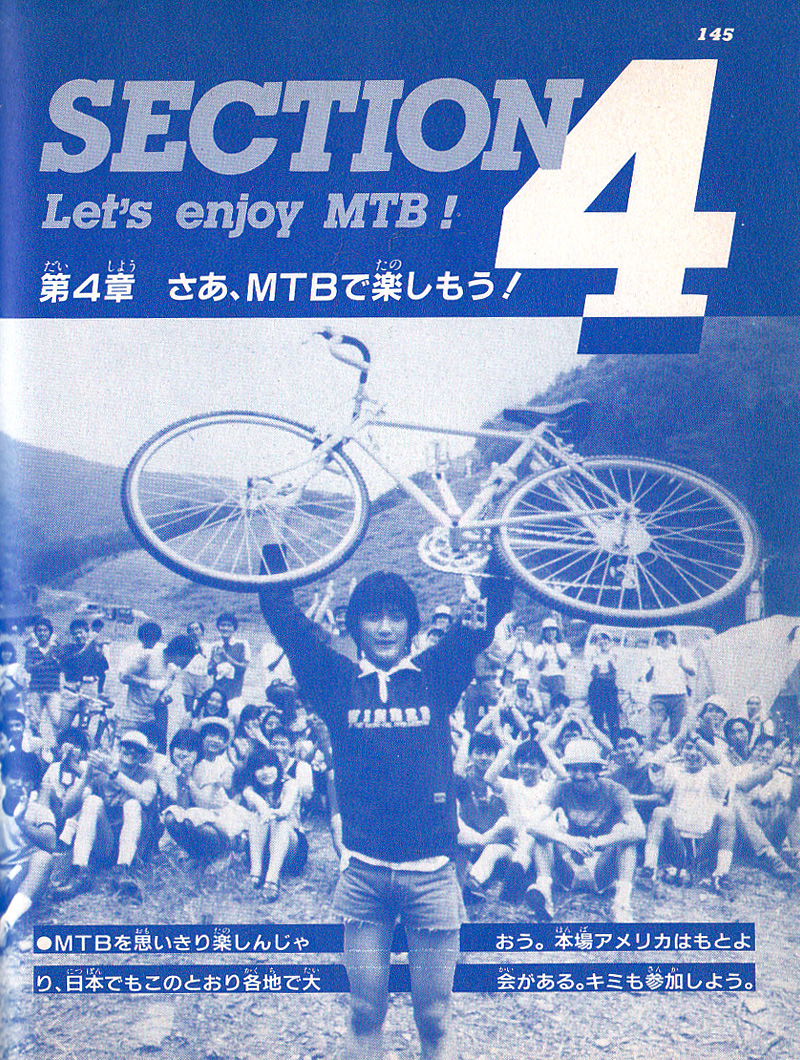
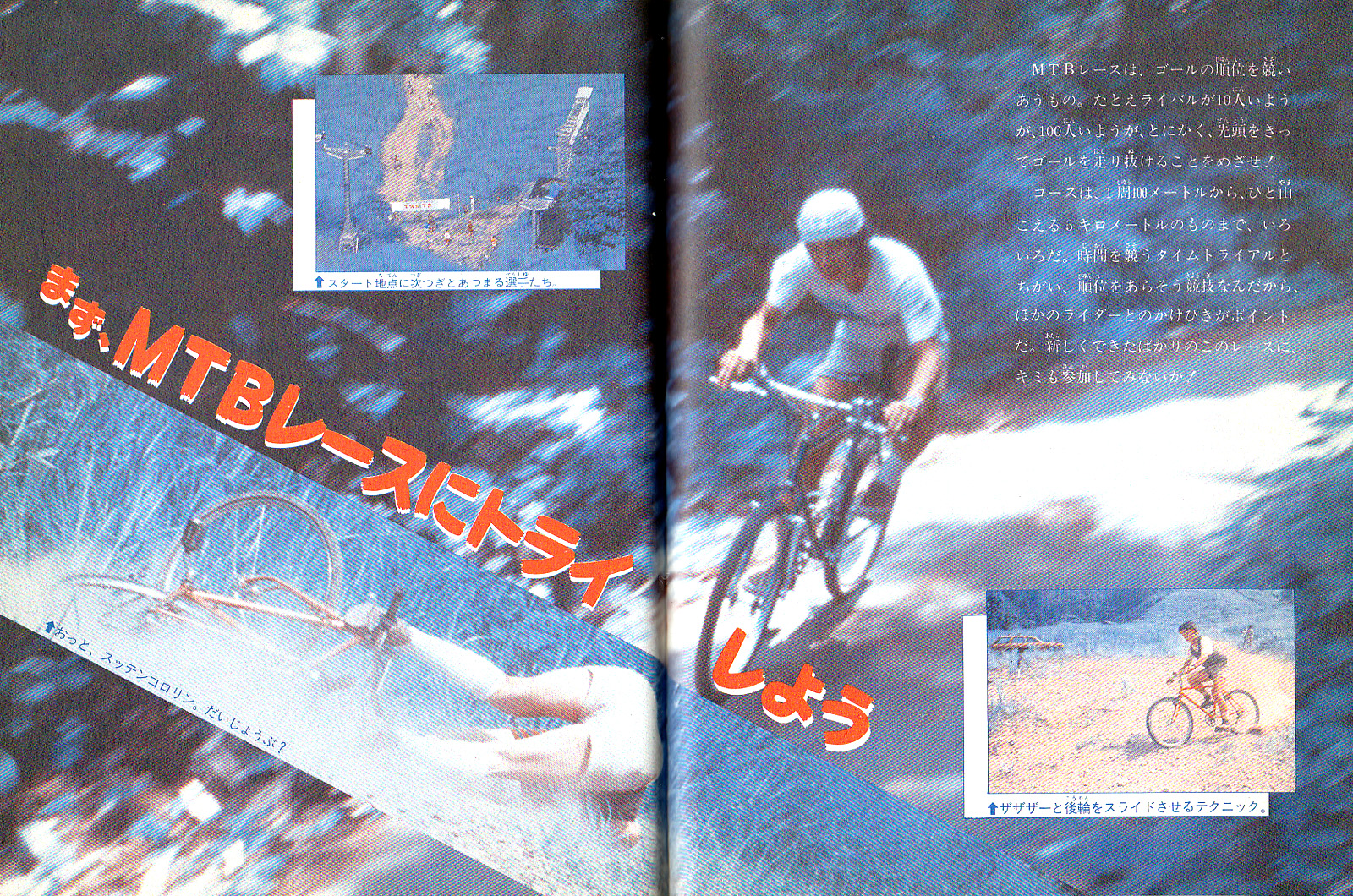
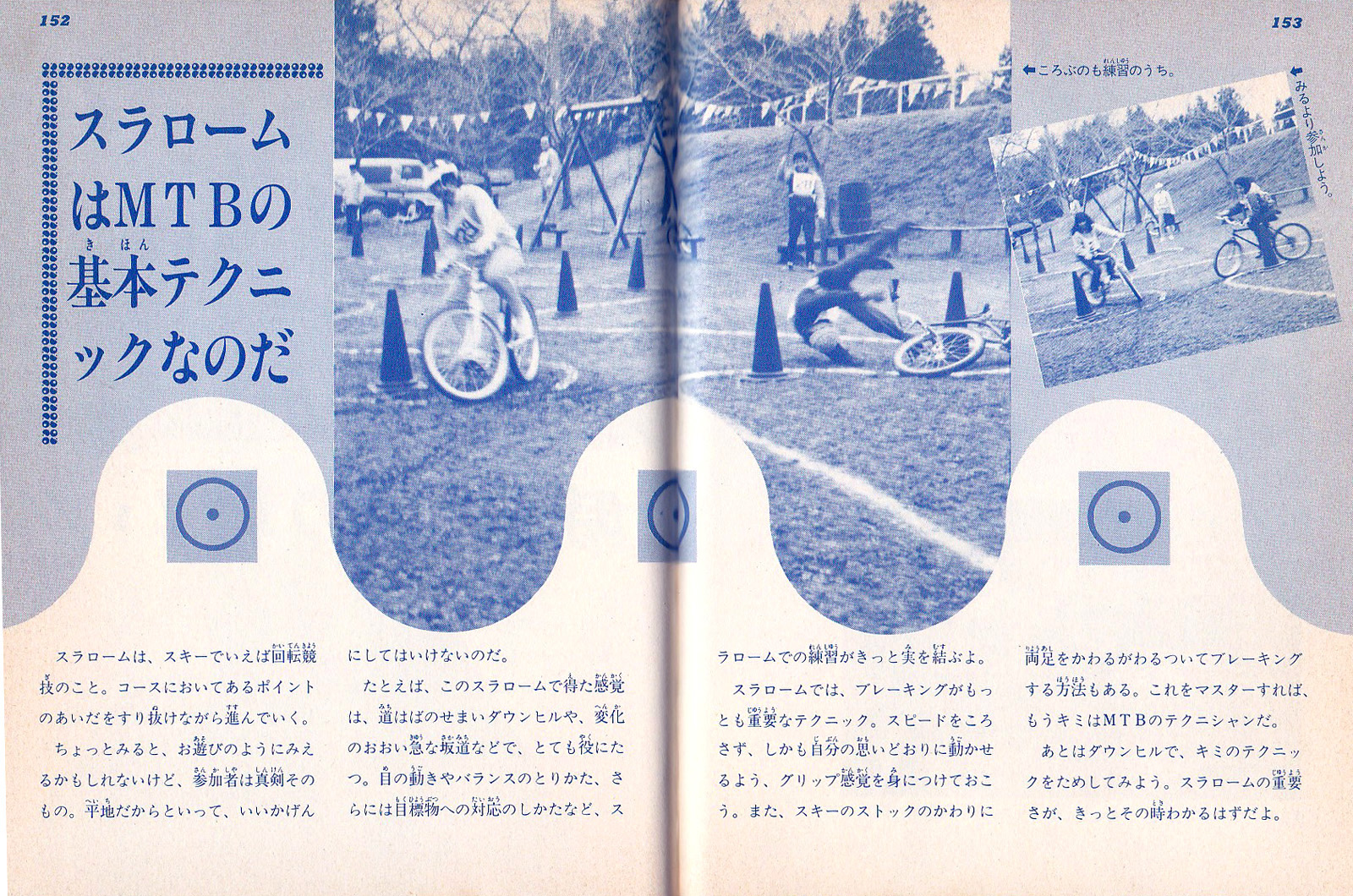
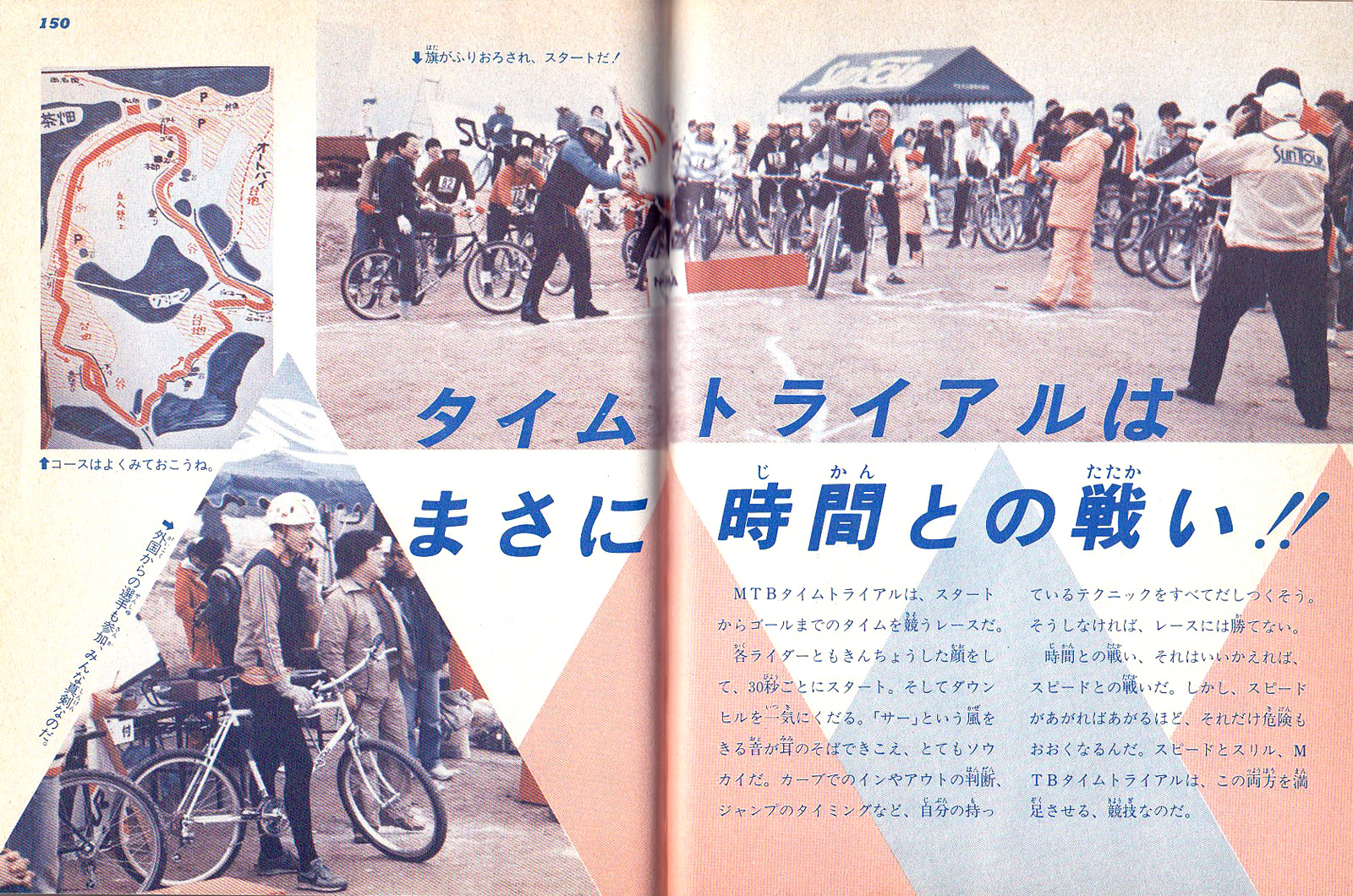
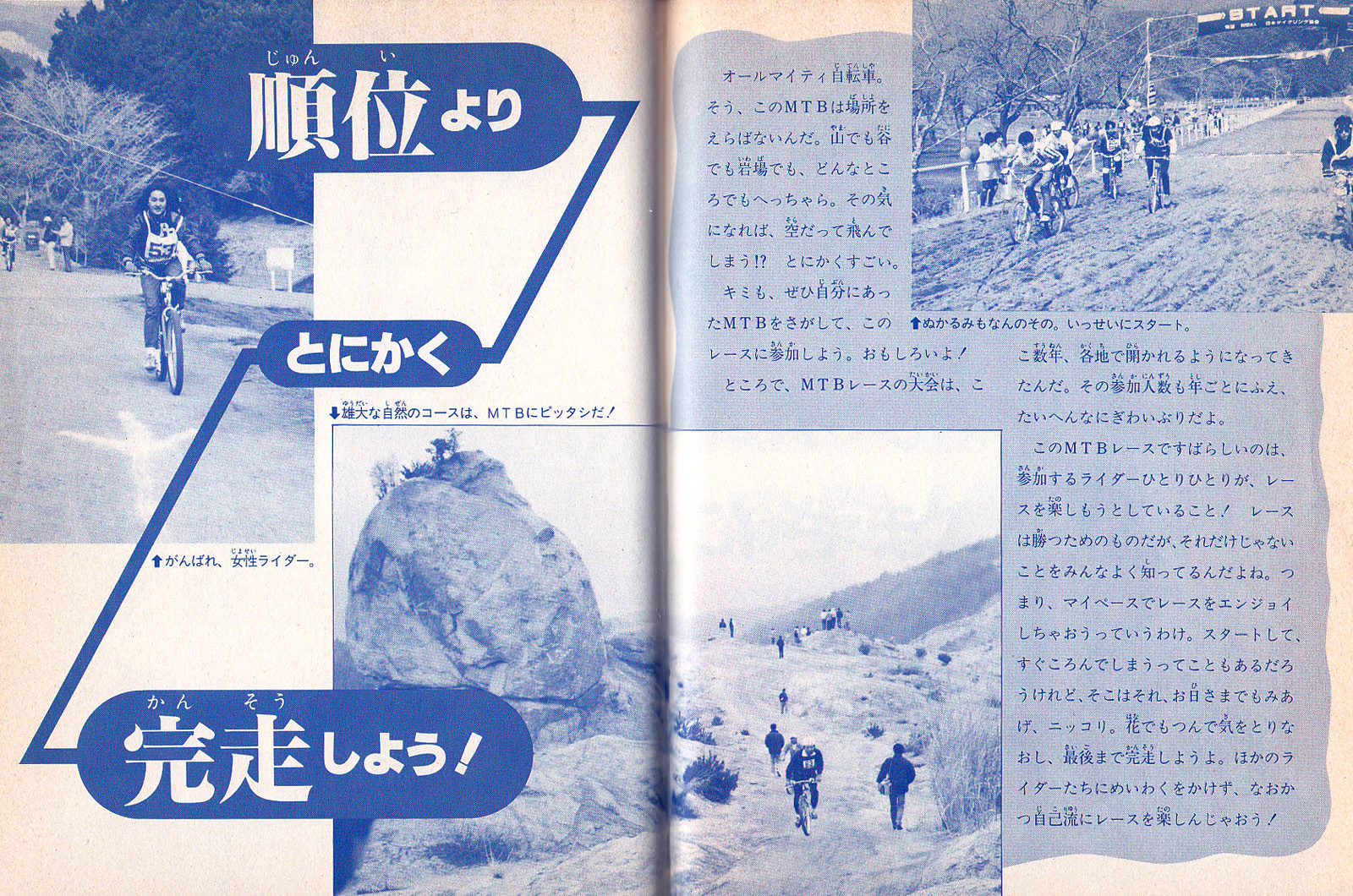
翌年からは、長野南佐久で毎夏、同様の大会の開催が続けられるようになった。1987年には日本マウンテンバイク協会(JMA)が設立される。初代JMA会長はイベント主催の筆頭協力者の平木氏が務めることとなった。
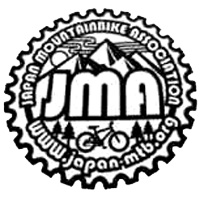
このレースのレポートはチャールズ・ケリーの手によってファットタイヤ・フライヤー(Fat Tire Flyer)誌、通巻20号(1984年9月/10月号)にも掲載されている。(ちなみにファットタイヤ・フライヤーの通巻1号は1980年8月/9月号、最終号は通巻32号(1987年3月/4月号)である)

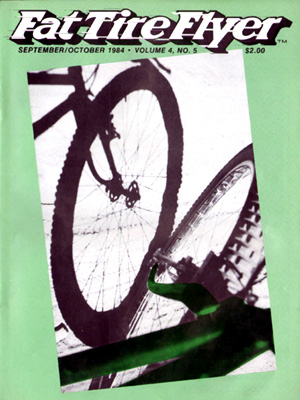
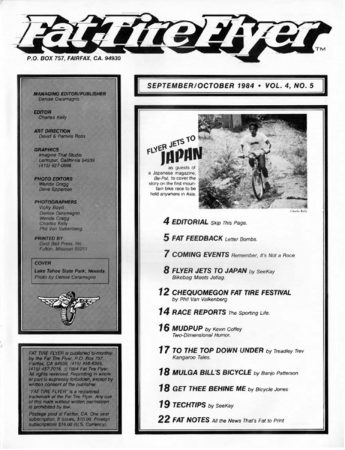
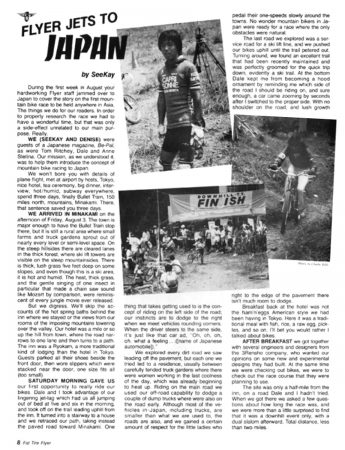
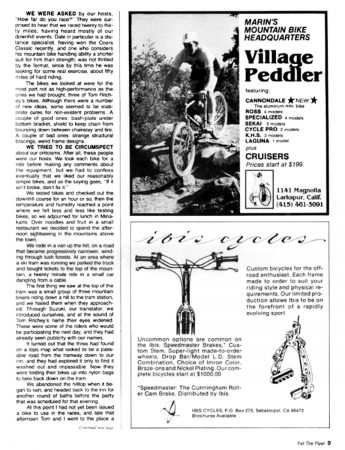
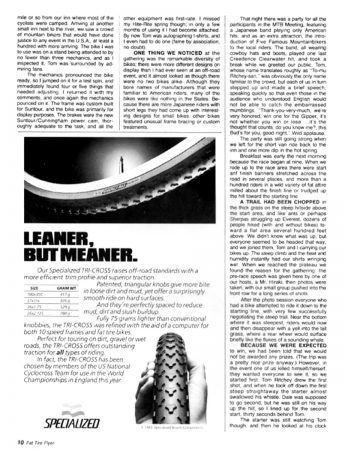
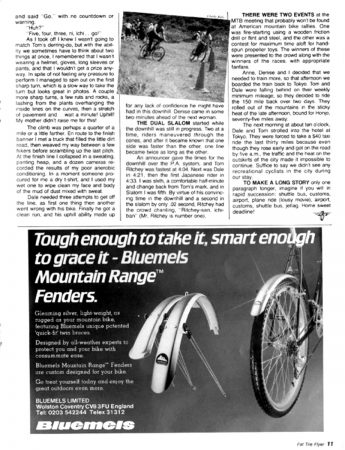
Flyer Jets to Japanby SeeKay During the first week in August, your hardworking Flyer staff jammed over to Japan to cover the story on the first mountain bike race to be held anywhere in Asia. The things we do for our readers. In order to properly research the race we had to have a wonderful time, but that was only aside-effect unrelated to our main purpose. Really. We (SeeKay and Denise) were guests of a Japanese magazine, Be-Pal, as were Tom Ritchey, and Dale and Anne Stetina. Our mission, as we understood it, was to help them introduce the concept of mountain bike racing to Japan. We won’t bore you with details of plane flight, being met at the airport by hosts, impressions of Tokyo, our nice hotel, the tea ceremony, big dinner, interview, hot/humid, subway everywhere, spend three days, finally Bullet Train, 150 miles north, mountains, Minakami. There, that sentence saved you three days. We arrived in Minakami on the afternoon of Friday, August 3. The town is major enough to have the Bullet Train stop there, but it is still a rural area where small farms and truck gardens sprout out of nearly every level or semi-level space. On the steep hillsides there are cleared lanes in the thick forest, where ski lift towers are visible on the steep mountaintopside. There is thick, lush grass five feet deep on some slopes, and even though this is a ski area, it is hot and humid. The heat, thick grass, and the gentle sing: ing of one insect in particular that made a chain saw sound like Mozart by comparison, were reminiscent of every jungle movie ever released. But we digress. We’ll skip the accounts of the hot spring baths behind the inn where we stayed or the views from our rooms of the imposing mountainstowering over the valley. Our hotel was a mile or soup the hill from town, where the road narrows to one lane and then turns to a path. The inn was a Ryokam, a more traditional kind of lodging than the hotel in Tokyo. Guests parked all their shoes beside the front door, then wore slippers which were stacked near the door, one size fits all (too small). Saturday morning gave us our first opportunity to really ride our bikes. Dale and I took advantage of our lingering jetlag which had us all jumping out of bed at five and six in the morning, and took off on the trail leading uphill from the inn. It turned into a stairway to a house and we retraced our path, taking instead the paved road toward Minakami. One thing that took getting used to was the concept of riding on the left side of the road, our instincts were to dodge to the right when we met vehicles rounding corners. When the driver steered to the same side, it was just like that carad, “Oh-oh, oh, oh, what a feeling… ([name of Japanese automobile])” We explored every dirt road we saw leading off the pavement, but each one we tried led to a residence, usually sited between carefully tended truck gardens where there were women working in the last coolness of the day, which was already beginning to heat up. Riding on the main road we used our off-road capability to dodge a couple of dump trucks where were also on the road early. Although most of the vehicles in Japan, including trucks, are smaller than what we are used to, the roads are smaller as well, and we gained a certain amount of respect for the little ladies who pedal their one-speeds slowly around the towns. No wonder mountain bikers in Japan were ready for a race where the only obstacles were natural. The last road we explored was a service road for a ski lift line, and we pushed our bikes uphill until the trail petered out. Turning around, we found an excellent trail that had been recently maintained and was perfectly groomed for the quick trip down, evidently aski trail. At the bottom, Dale kept me from becoming a hood ornament by reminding me which side of the road I should be riding on, and sure enough, a car came zooming by seconds after I switched to the proper side. With no shoulder on the road, and lush growth right to the edge of the pavement, there isn’t much room to dodge. Breakfast back at the hotel was not the ham ‘n’ eggs American style we had been having in Tokyo. Here it was a traditional meal with fish, rice, a raw egg, pickles, and so on. I’ll bet you would rather I talked about bikes. After breakfast we got together with several engineers and designers from the 3Rensho bicycle company, who wanted our opinions on some new and experimental designs they had built. At the same time we were checking out bikes, we were to check out the race course that they were planning to use. The site was only a half-mile from the inn, on a road Dale and I hadn’t tried. When we got there, we asked a few questions about how long the race was, and we were more than a little surprised to find that it was a downhill event only, with a dual slalom afterward. Total distance: less than two miles. We were asked by our hosts, “How far do you race?” They were surprised to hear that we raced 20 to 30 miles, having heard mostly of our downhill events. Dale in particular is a distance specialist, having won the Coors Classic recently, and one who considers his mountain bike handling ability a shorter suit for him than strength. He was not thrilled by the format, since by this time he was looking for some real exercise, about 50 miles of hard riding. The bikes we looked at were for the most part not as high-performance as the three Tom Ritchey bikes we had brought. Although there were a number of new ideas, some seemed to be elaborate cures for non-existent problems. A couple of good ones: bash plate under bottom bracket, and a shield to keep the chain from bouncing down between the chainstay and tire. A couple of bad ones: strange structural bracings, weird frame designs. We tried to be circumspect about our criticisms. After all, these people were our hosts. We took each bike for a ride before making any comments about the equipment, but we had to confess eventually that weliked our reasonably simple bikes, and as the saying goes, “If it ain’t broke, don’t fix it.” We tested bikes and checked out the downhill course for an hour or so, until the temperature and humidity reached a point where we felt less and less like testing bikes. We adjourned for lunch in Minakami. Over noodles and fruit in a small restaurant, we decided to spend the afternoon sightseeing in the mountains above the town. We rode in a van up the hill, ona road that became progres sively narrower, winding through lush forests. At an area where a ski tram was running we parked the truck and bought tickets to the top of the mountain, a 20-minute ride in a small car dangling from a cable. The first thing we saw at the top of the tram was a small group of three mountain bikers riding down a hill to the tram station, and we hailed them when they approached. Through Suzuki, our translator, we introduced ourselves, and at the sound of Tom Ritchey’s name their eyes widened. These were some of the riders who would be participating the next day, and they had already seen publicity with our names. It turned out that the three had found on a topo map what looked to be a passable road from the tramway down to our inn, and they had explored it only to find it washed out and impassable. Now they were folding their bikes into nylon bags to take back down on the tram. We abandoned the hilltop when it began to rain, and headed back to the inn for another round of baths before the party that was scheduled for that evening. At this point I had not yet been issued a bike to use in the races, and late that afternoon Tom and I went to the place a mile or so from our inn where most of the cyclists were camped. Arriving at another small inn next to the river, we saw a crowd of mountain bikers that would have done justice to any event in the United States, at least a hundred riders with more arriving.The bike I was to use was on a stand being attended to by no fewer than three mechanics, and as I inspected it, Tom was surrounded by admiring fans. The mechanics pronounced the bike ready, so I jumped on it for a test spin, and immediately found four or five things that needed adjusting. I returned it with my comments, and once again the mechanics pounced on it. The frame was custom built for SunTour, and the bike was primarily for display purposes. The brakes were the new SunTour/Cunningham power cam, thoroughly adequate to the task, and all the other equipment was first-rate. I missed my HiteRite spring though; in only a few months of using it I had become attached. By now Tom was autographing T-shirts, and I even had to do one (fame by association, no doubt). One thing we noticed at the gathering was the remarkable diver. sity of bikes; there were more different designs on display than I had ever seen at an off-road event, and it almost looked as though there were no two bikes alike. Although they bore names of manufacturers that were familiar to American riders, many of the bikes were like nothing in the States. Because there is a high proportion of riders with short legs in Japan, they had come up with interesting designs for small bikes; other bikes featured unusual frame bracing or custom treatments. That night there was a party for all the participants in the MTB Meeting, featuring a Japanese band playing only American hits, and as an extra attraction, the introduction of Five Famous Mountainbikers to the local riders. The band, all wearing cowboy hats and boots, played one last Creedence Clearwater hit, and took a break while we greeted our public. Tom, whose name translates roughly as “To-mu Ritchey-san” was obviously the only name familiar to the crowd, but each of us in turn stepped up and made a brief speech, speaking quickly so that even those in the audience who understood English would not be able to catch the embarrassed mumblings. “Thank-you-very-much, we’re very honored, win one for the Gipper, it’s not whether you win or lose, it’s the thought that counts, do you know me?, this Bud’s for you, good night” Wild applause. The party was still going strong when we left for the short van ride back to the inn and one more dip in the hot spring. Breakfast was early the next morning because the race began at nine. When we rode up to the race area there were start and finish banners stretched across the road in several places, and more than a hundred riders in a wild variety of fat attire milled about the finish line or trudged up the hill toward the starting line. A trail had been chopped in the thick grass on the steep hillside above the start area, and like ants or perhaps Sherpas struggling up Everest, dozens of people hiked (with and without bikes) toward a flat area several hundred feet above. We didn’t know what was up, but everyone seemed to be headed that way, and we joined them, Tom and I carrying our bikes up. The steep climb and the heat and humidity instantly had our shirts wringing wet. When we reached the plateau we found the reason for the gathering: the pre-race speech was given hereby one of our hosts, a Mr. Hiraki, then photos were taken, with our small group pushed into the front row for a long series of shots. After the photo session everyone who had a bike attempted to ride it down to the starting line, with very few successfully negotiating the steep trail. Near the bottom where it was steepest, riders would now and then disappear with a yell into the tallgrass, wherea rear wheel would surface briefly like the flukes of a sounding whale. Because we were expected to win, we had been told that we would not be awarded any prizes. (The trip was a pretty nice prize anyway.) However, in the event one of us killed himself/herself, they wanted everyone to see it, so we started first. Tom Ritchey drew the first shot, and when he took off down the first steep straightaway the starter almost swallowed his whistle. Dale was supposed to go second, but he was still on his way up the hill, so I lined up for the second start, thirty seconds behind Tom. The starter was still watching Tom though, and then he looked at his clock and said “Go” with no countdown or warning. As I took off I knew I wasn’t going to match Tom’s derring-do, but with the ability we sometimes have to think about two things at once, I remembered that I wasn’t wearing a helmet, gloves, long sleeves or pants, and that I wouldn’t get a prize anyway. Inspite of not feelingany pressure to perform, I managed to spin out on the first sharp turn, which is a slow way to take the turn but looks great in photos. A couple more sharp turns, a few ruts and rocks, a lashing from the plants overhanging the insidelines on the curves, then a stretch of pavement and …wait a minute! Uphill! My mother didn’t raise me for this! The climb was perhaps a quarter of a mile or a little farther. En route to the finish banner I meta truck that filled the little dirt road. then weaved my way between a few hikers before scrambling up the last pitch. At the finish line I collapsed in a sweating panting heap, and a dozen cameras recorded the results of my poor anaerobic conditioning. In a moment someone procured for me a dry T-shirt, and I used my wet one to wipe clean my face and body of the mud of dust mixed with sweat. Dale needed three attempts to get off the line, as first one thing then another went wrong with his bike. Finally he got a clean run, and his uphill ability made up for any lack of confidence he might have had in this downhill. Denise came in some two minutes ahead of the next woman. The dual slalom started while the downhill was still in progress. Two at a time, riders maneuvered through the cones, and after it became known that one side was faster than the other, one line became twice as long as the other. An announcer gave the times for the downhill over the PA system, and Tom Ritchey was fastestat 4:04, Next was Dalein 4:21, then the first Japanese rider in 4:33.1 was sixth, a comfortable half-minute and change back from Tom’s mark, and in Slalom I was fifth. By virtue of his convincing time in the downhill and a second in the slalom by only 0.02 second, Ritchey had the crowd chanting, “Ritchey-san, ichiban” (Mr. Ritchey is number one). There were two events at the MTB meeting that probably won’t be found at American mountain bike rallies. One was fire-starting using a wooden friction drill or flint and steel, and the other was a contest for maximum time aloft for handsprun propeller toys. The winners of these were presented to the crowd along with the winners of the races, with appropriate fanfare. Anne, Denise and I decided that we needed to train more, so that afternoon we boarded the train back to Tokyo Tom and Dale were fallingbehind on their weekly minimum mileage, so they decided to ride the 150 miles back over two days. They rolled out of the mountains in the sticky heat of the late afternoon, bound for Honjo, 75 miles away. The next morning at about ten o’clock, Dale and Tom strolled into the hotel at Tokyo. They were forced to take as 10 taxiride the last 30 miles because even though they rose early and got on the road by 5 a.m., the traffic and the heat on the outskirts of the city made it impossible to continue. Suffice to say we didn’t see any recreational cyclists in the city during our stay. To make a long story only one paragraph longer, imagine if you willinnapidsuccession: shuttlebus, customs, airport, planeride (lousy movie), airport, customs, shuttlebus, jetlag Home sweet deadline! |
このイベントに三連勝は、前後ディスクブレーキ、トリプルツリーを採用したワークスマシンを引っ提げ参加した。
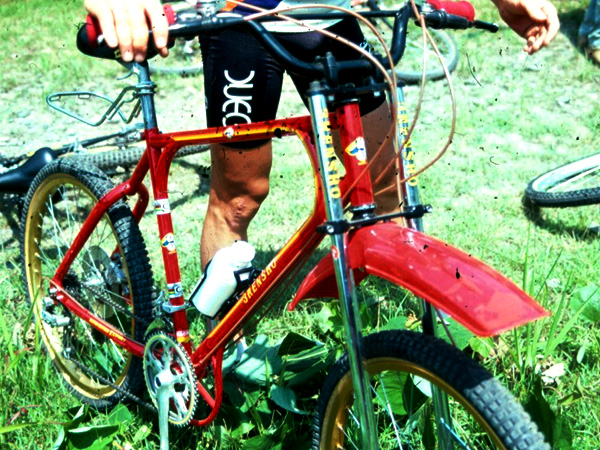
三連勝は、その実験的デザインをリッチーやケリーに意見を求めている。私自身は、現在のダウンヒルレーサーがもれなくそうなっているのを鑑みれば、ズバ抜けて先見の明のあるデザインと感嘆させられた。(これでサスペンションが装備されていれば・・・)さらに製作時期が日本のMTB黎明期の1984年の事実も考えれば、もはやオーパーツと言っていいレベルにあると思う。
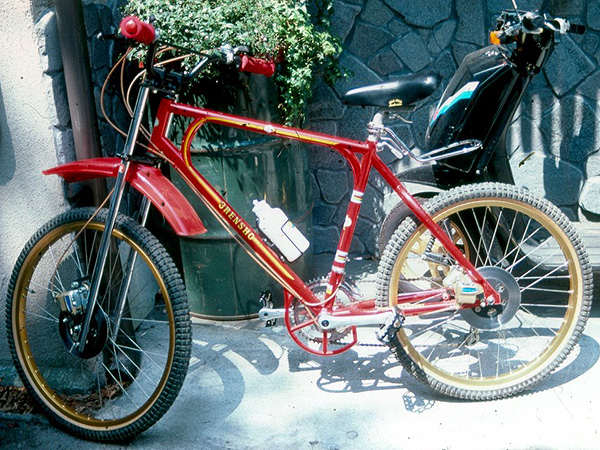
しかし、残念ながら三連勝のマシンは当時の彼らの嗜好には合わなかったようだ。さすがに直接伝えることはしなかったようだが、上記のファットタイヤ・フライヤー誌上で、これらの装備はギミックとして厳しい評価がなされている。(特に三連勝製を印象付けるフレーム補強は不評であった)
もちろん良いところも挙げており、BB下のバッシュプレートとチェーンが外れるのを防ぐガイドの2点を誉めているが、その後の彼らの「作品」に真似られることはなかったようだ。





